Gardens of eastern Sicily
Wednesday 11 – Wednesday 18 May 2022
Day 1
Just as there is a danger in relying on Shakespeare for historical veracity, so one should not base one’s preconceptions of Sicily on Mario Puzo or Giuseppe di Lampedusa, with Greek myth and legend thrown in. These fictions were the basis of my expectations which this visit has somewhat debunked.
Having greeted the dawn at Gatwick, and whiled away a few hours at Catania airport as our group of 20 foregathered from various parts of Europe, I was grateful that our first garden proved to be a haven of tranquility. The Commenda San Calogero, conveniently situated not far from the airport at Villasmundo, is an estate of 44.5 hectares originating from the 12th century and approached through lemon groves, clumps of Perovskia atriplicifolia (synonym: Salvia yangii) and the inevitable prickly pear Opuntia ficus-indica (brought from Mexico by the Spanish in the 15th century).

Commenda San Calogero (Andrea facing)
Andrea, the son of the present owners and an architect and garden designer, showed us round starting in the cool interior of the 17th century house, built round a large square courtyard, where we were treated to cold drinks and delicious lemony ricciarelli biscuits. From there we descended into the garden which was largely created by Andrea’s grandparents in the 1920s. Soil and water had to be imported from the river valley below and it was planted with many palms and cypress trees, most of which Andrea removed in order to open up the vista and lead the eye to a long pond inspired by the Alhambra with a Delhi-inspired pavilion at the end. Down each side Andrea had planted squares of box hedging, the remaining mature trees at each corner and the interior containing a pleasing jumble of jacarandas underplanted with agapanthus, a feast of blue in June, and old roses (May Queen) rambling through. In addition was the Judas tree Cercis siliquastrum, pink scented pelargoniums, euphorbias and Trachelospermum jasminoides Star of Toscana. Lining the length of the long pond were orange trees underplanted with mixed herbaceous plants and stunning old gold flag irises.
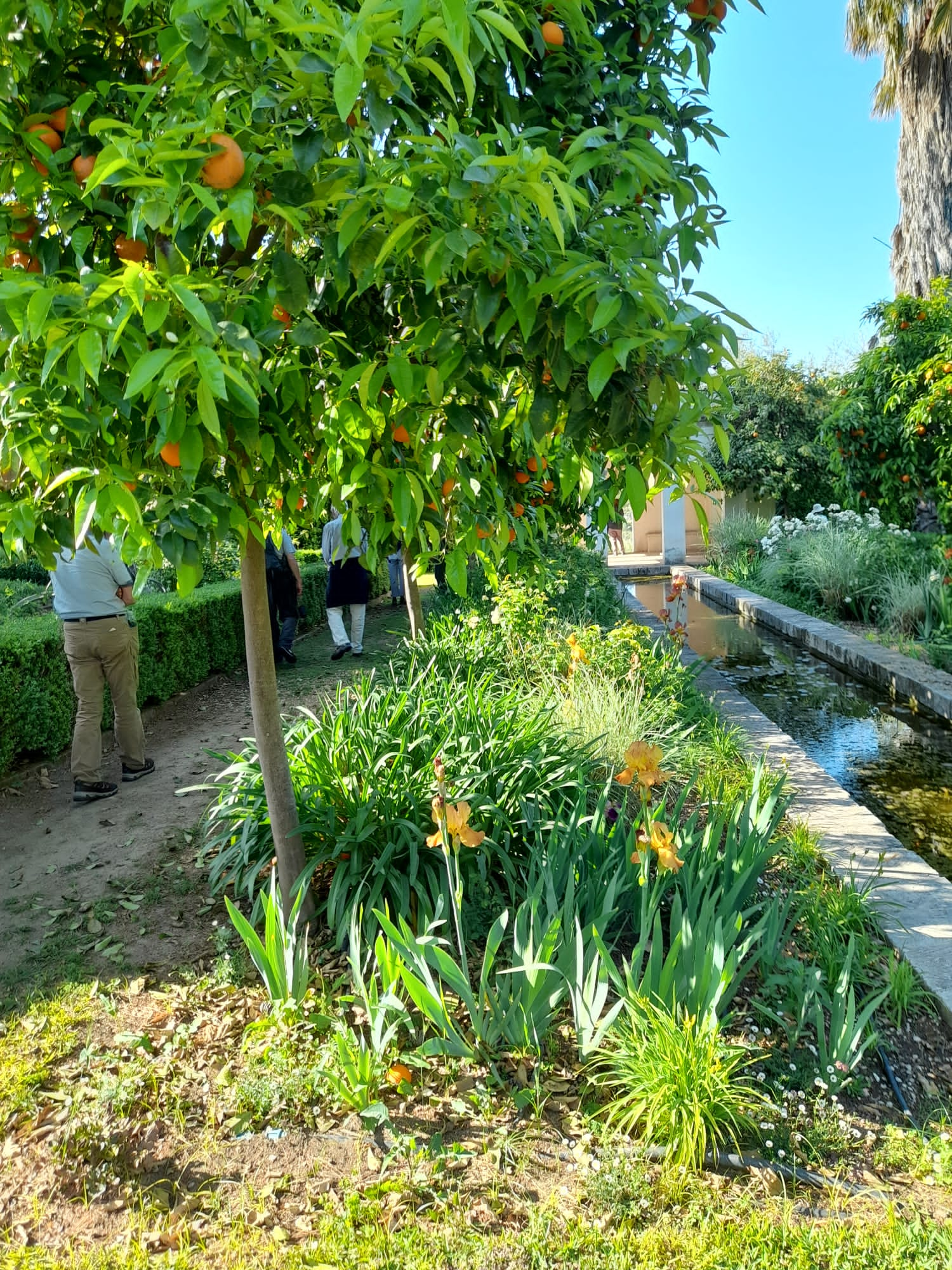
Alhambra-inspired pond
Behind the pavilion we entered another part of the garden overlooking the citrus-planted valley and made up of an avenue of olive trees underplanted with pale blue flag irises. The trees had been transplanted from part of the estate where a motorway was being driven through. At the end of the avenue was a large laurel hedge and the whole was hidden from view by the random planting of native Mediterranean trees.
We left the garden via an open area with plane trees, constantly flowering Rosa chinensis, Cistus and a hedge of yellow Bulbine.

Arriving at our Catania hotel we and our luggage were hurried through reception to a lecture given by Professor Daniela Romano from the Department of Agriculture, Food and Environmental Science at the University of Catania (lecture illustrations and notes available here). The theme of the lecture, true of everywhere we went, was climate change and I was introduced to the word ‘xeriscaping’, this being the process of landscaping or gardening that reduces or eliminates the need for irrigation. Our guide for the week, Sergio Cumitini, was later to tell us that last summer temperatures rose to 49°C for several days and averaged 46°C for more than two weeks. He also said that Sicily has more rainfall than Tuscany but, as many of us are experiencing, the rain is monsoonal in nature.
Day Two
Still feeling somewhat poleaxed from a long first day crowned with a four-course dinner, we departed for Taormina and a visit to Casa Cuseni, the extraordinary home of painter Robert Kitson, a scion of a Yorkshire industrial family. Kitson settled in Sicily in 1903, buying a hillside for £35 and building a house 800m above the sea. Ostensibly escaping England for his health, he chose Taormina as a more tolerant society where he and his young Sicilian lover, Carlo Siligato, could live relatively untroubled lives. The house, known as an ‘English house in Italy’ and now an official National Monument and museum, is built and decorated in a mix of the Arts and Crafts movement and Sicilian style.
The dining room, with chairs by Charles Rennie Mackintosh, was designed by a friend of Kitson’s – Sir Frank Brangwyn, a student of William Morris – and is lined with panelling and allegorical frescoes depicting Carlo, amongst others, and a baby. The latter was found abandoned and brought up by the two men. Robert Kitson was an avid collector and the house is full of interesting items including artefacts from Pompeii, ivory and ebony caskets, busts and paintings and a library of books, many of which are first editions given by the authors when guests at the house. Leaving the island during WWII his collection was removed by the local inhabitants and hidden until Robert Kitson returned, such was their affection for him. Dying in 1948 the house was inherited by his niece, Daphne Phelps, who rented out rooms to illustrious and disparate guests such as Pablo Picasso, Tennessee Williams, Bertrand Russell, Roald Dahl and Greta Garbo. Three of our group sat on what was said to be Garbo’s favourite sofa.
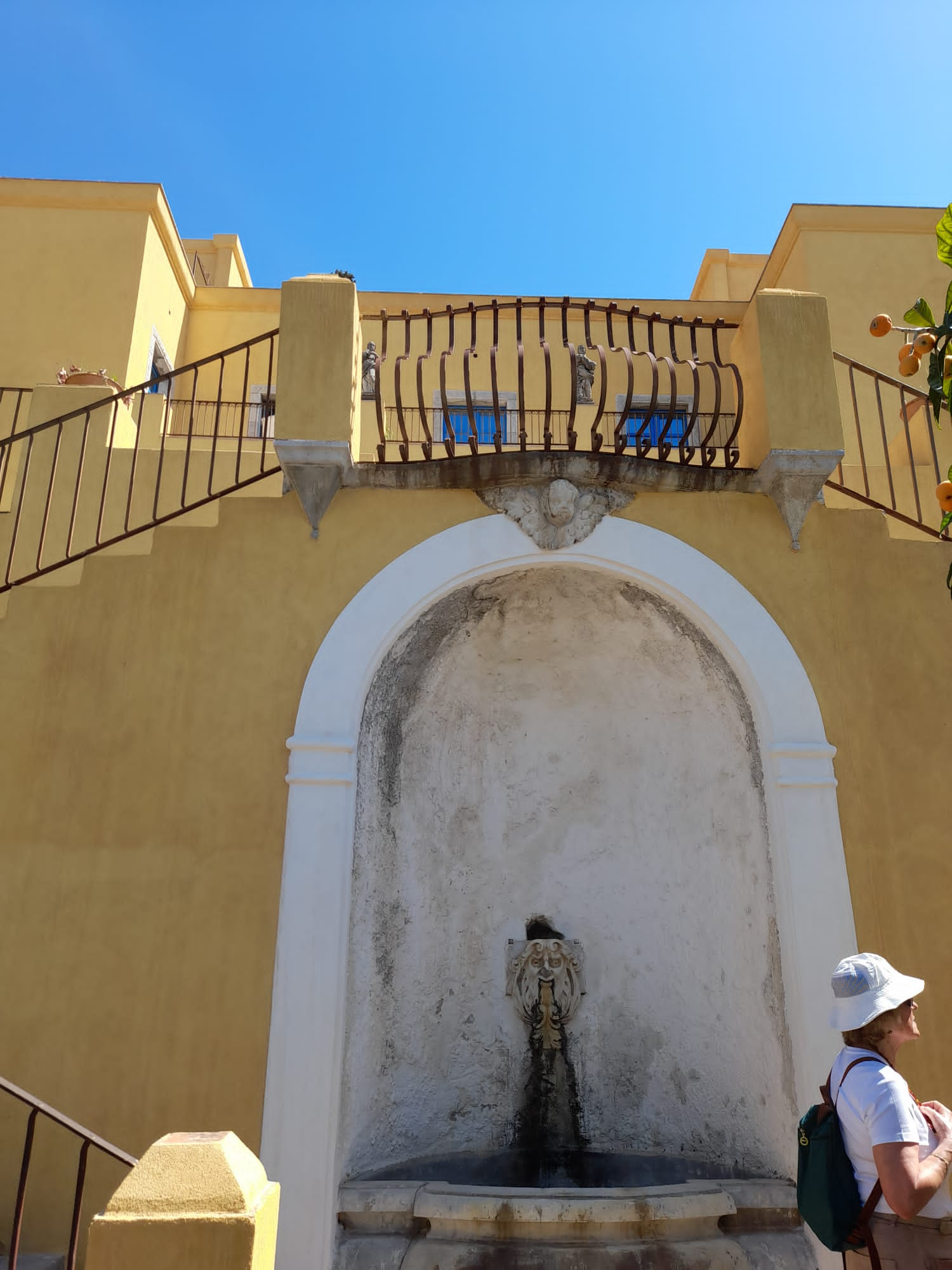
Casa Cuseni
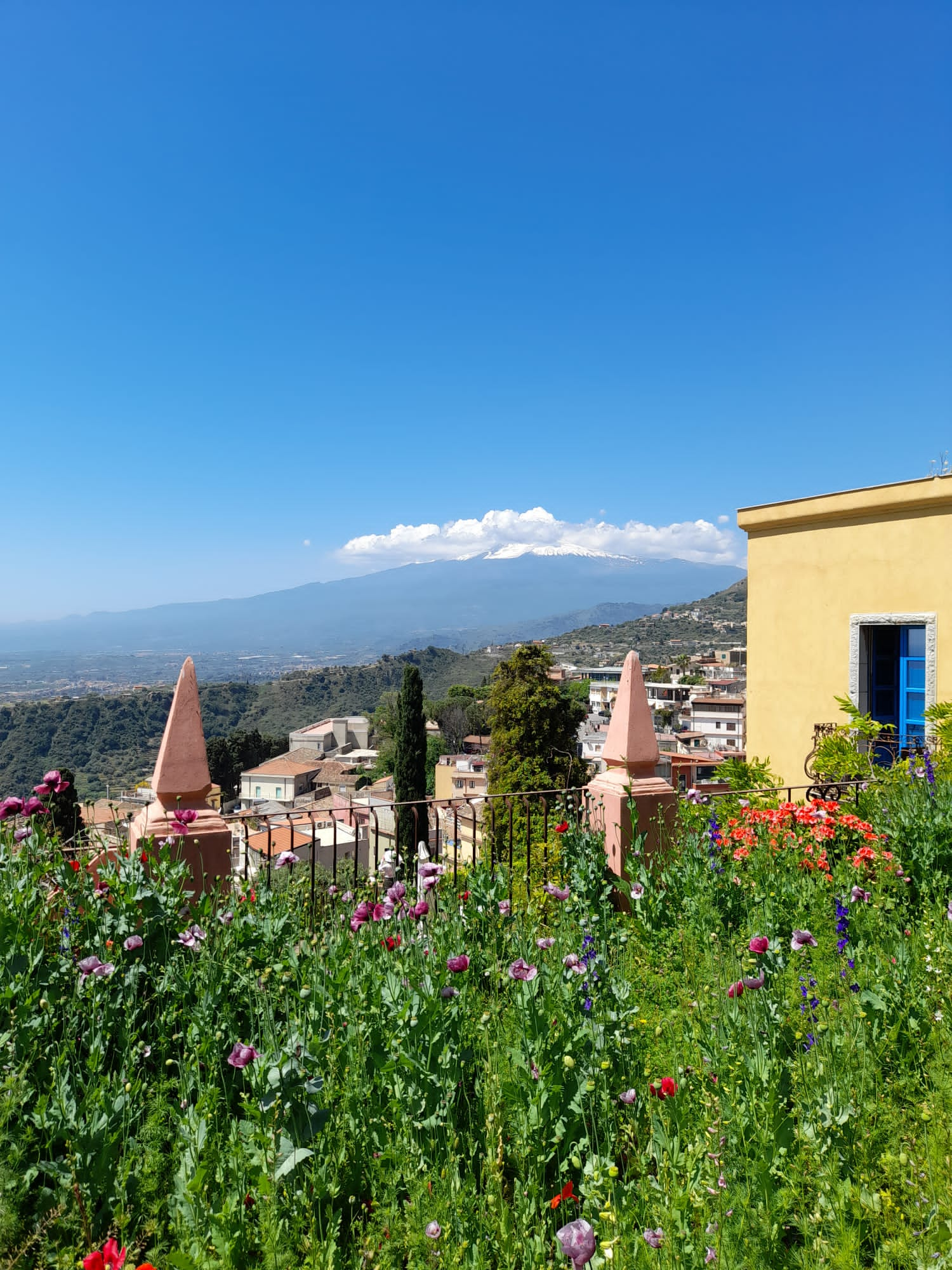
View from Casa Cuseni
The garden of Casa Cuseni was partially based on William Blake’s illustrations of Dante’s Divine Comedy and partially the futuristic view of the painter Giacomo Balla, with pebble pathways, water features, troughs and Sicilian tiling all overhung by loquat trees, a pretty Australian Lagunaria patersonia and a profusion of wild flowers.
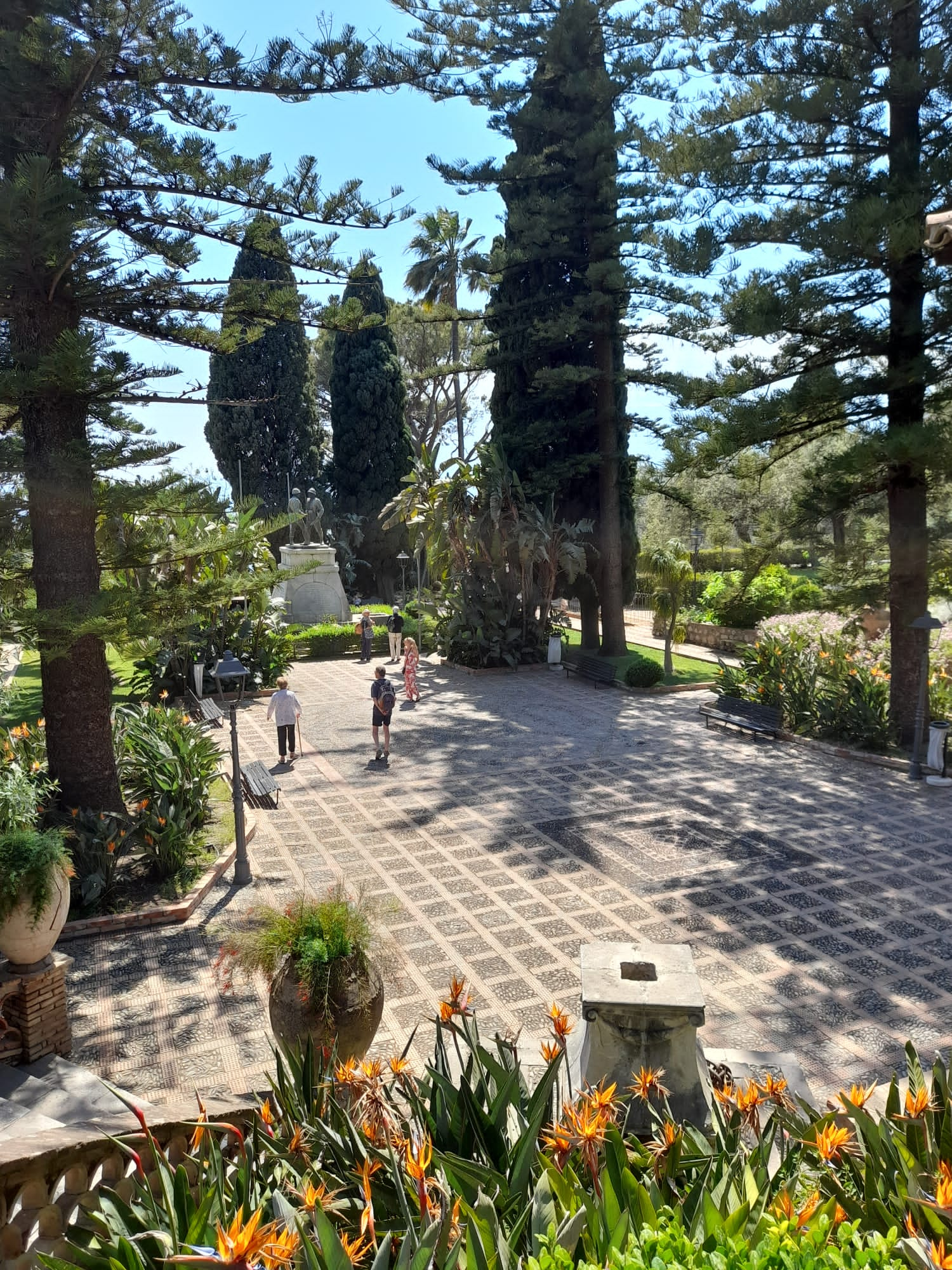
Villa Communale
Lunch in the town – a never-ending supply of excellent pizzas – was followed by a visit to the municipal gardens of the Villa Communale, the creation and once the property of a former mistress of Edward VII, Lady Florence Trevelyan. It was a very attractive and leafy space with cypresses, paving, war memorials, pavilions and a wonderful view over the sea, and all overhung with hibiscus and bougainvillea. The afternoon was free and some of our group went to see the equally beautifully situated and impressive Greco-Roman amphitheatre.

Greco-Roman amphitheatre, Taormina
Day 3
Villa Trinità, Mascalucia. Here we were met by the loquacious and amusing Salvatore Bonajuto who immediately showed us the attractive hedge he had “invented” of bitter oranges before leading us round the 3 hectare property that had been in his family for seven generations. Originally a vineyard then a citrus plantation, it became a garden relatively recently but long enough to have many mature trees including the Peruvian false pepper tree Schinus molle, the Chinaberry tree Melia azedarach, plane trees, cork oak and the kapok tree Ceiba pentandra. Everywhere were signs of being situated close to Mount Etna with lava boulders dating from as long ago as 1382 and pathways and walls made from bricks of lava with exposed ground top-dressed with volcanic ash. The latter was also used in one of Salvatore’s artworks depicting the volcano with a flow of bronze coming from the top. Originally a landscape architect, Salvatore was now turning most of his attention to art with the gardens as a backdrop for his own and the works of others, many signifying Earth and Nature.
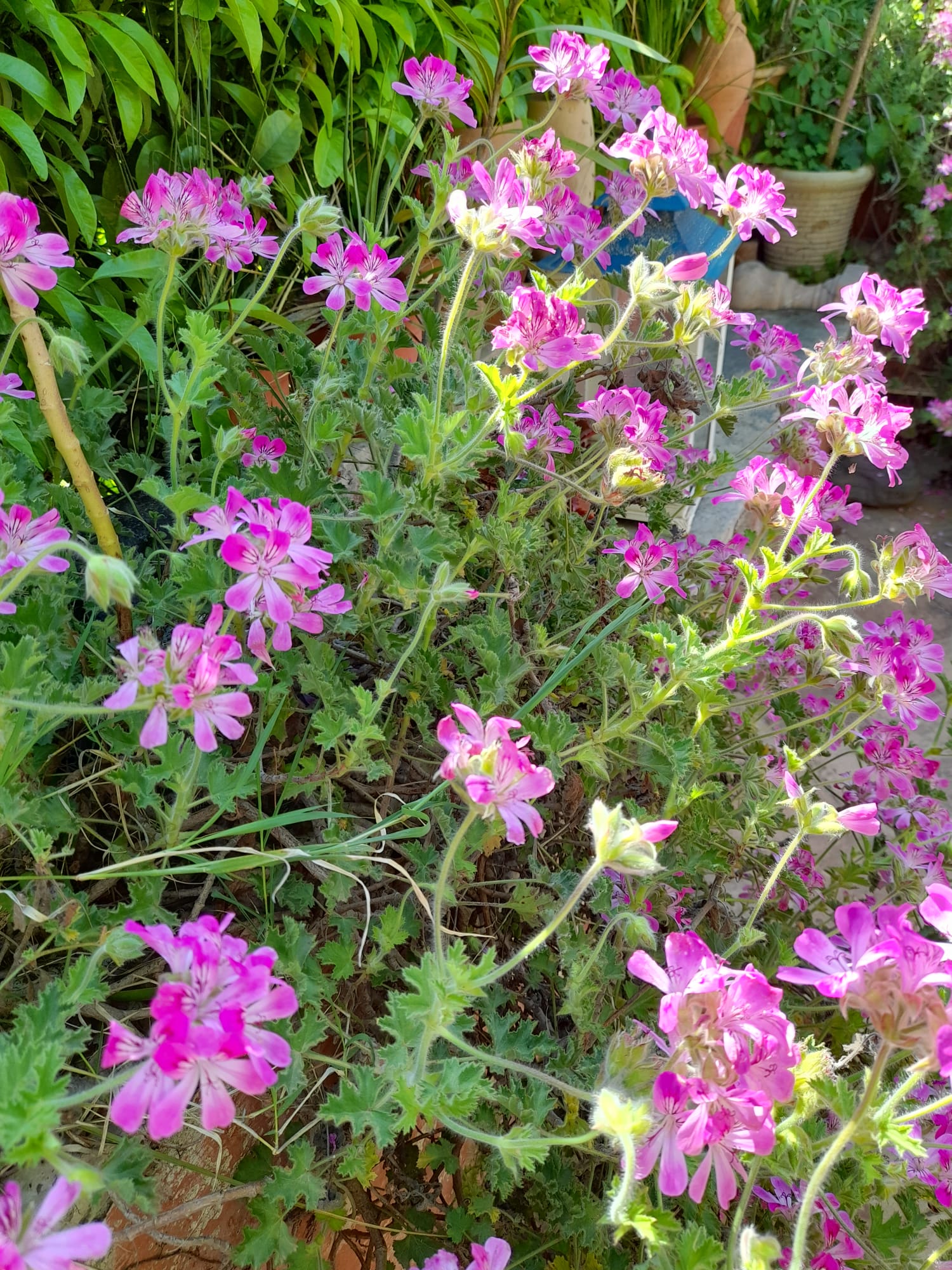
Pelargonium

Agave at Villa Trinita, Mascalucia
Everywhere in this garden were interesting, non-native, plants such as tree ferns, the orchid-tree Bauhinia, the Queensland bottle-tree Brachychiton rupestris, many Agave americana, Bonapartea filamentosa and Yucca desmetiana intermingling with the native Genista aetnensis and Quercus pubescens. The latter used to be found all over the slopes of Etna but has only reappeared where no chemicals are used.
Our next port of call was the astounding Piante Faro Nursery at Giarre. The sheer size of this operation was mind-blowing. At 600 hectares divided into 21 zones, the nursery is the largest in Italy and caters for the wholesale market, funnelling most of the UK-bound plants via Dutch distributors. We were shown trees, such as the Washingtonia palm, up to 12m height, the maximum they can transport, and at least 25 years old, so one doesn’t have to be in finance to realise how much money is tied up in stock. We were also shown the oldest known living carob Ceratonia siliqua at 1300 years and looking like a great wounded elephant – the owner’s pet. Towards the end of our tour we went into a conservatory-type showroom where buyers come to select the smaller houseplants, destined for supermarkets, and the larger Strelitzia augusta, up to 10m, grown for the Arab market.
Lunch was at another branch of the nursery, Donna Carmela, run as a boutique hotel and hedged with Thunbergia laurifolia, and was followed by a walk around some of the exhibits at the Radicepura Garden Festival.
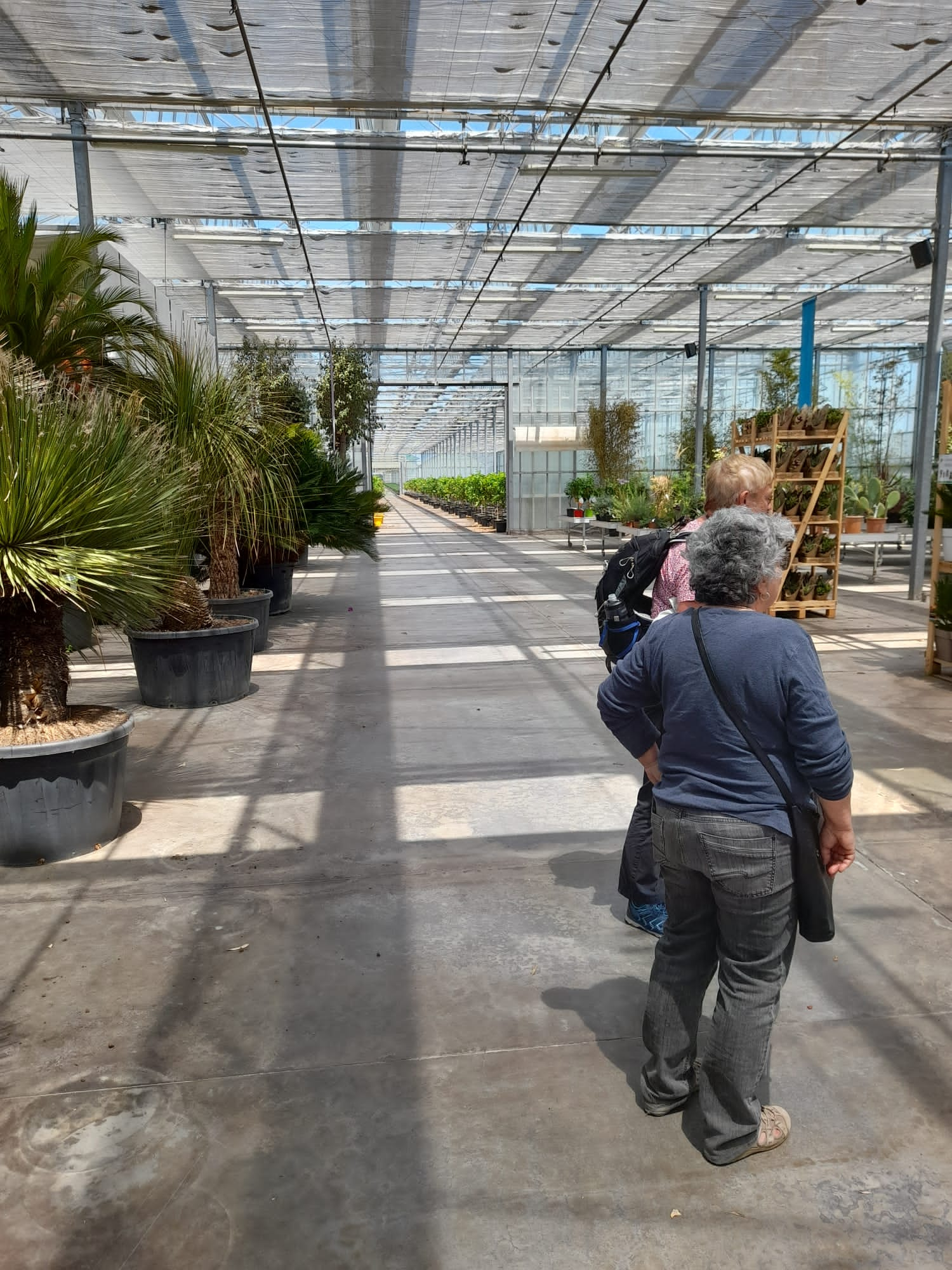
Mona Abboud at Piante Faro Nursey
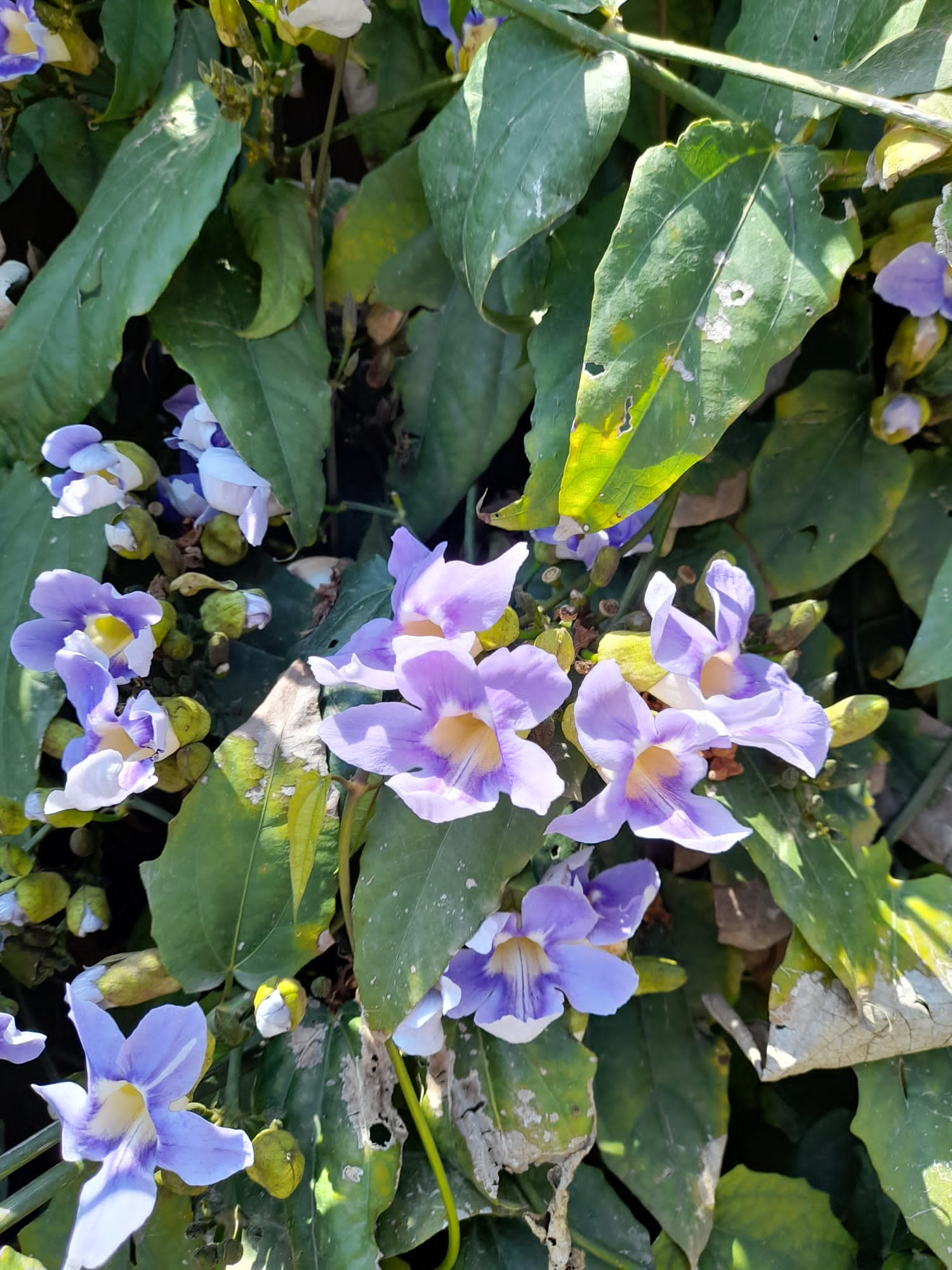
Thunbergia laurifolia
Our final visit of the afternoon was to the Villa Pennisi at Acireale. The enclosed garden was a wonderful oasis of late Victorian/Edwardian elegance and the villa had been a spa hotel, due to thermal springs, but gutted by fire in the 1880s. We were shown round by the present owners, a delightful couple exuding the elegance of the gardens who are in the slow process of restoring the property.
Within the garden were some trees that predate the hotel such as Washingtonia and Chamaerops humilis. Also Cycas, Camellia, clumps of Strelitzia, Jacaranda and the very pretty Ceiba speciosa, the floss silk tree (formerly Chorisia speciosa) with its bulbous lower trunk studded all over with spikes, as well as walnut, pine and mulberry. At one end was a coffee house for the use of the guests, which was a bizarre representation of a Roman temple being engulfed by lava, and in the middle was a wonderful late 18th century gazebo (looking like a small seaside bandstand) and a pond with art nouveau fencing. It was beside this gazebo that our hosts graciously served us with prosecco and canapés.
Day 4
Botanic Garden Nuova Gussonea and Crateri Silvestri, Etna. I should mention that Etna, the volcano, was never far from our sight as we drove around the Catania area. Looking not unlike pictures of Mount Fuji and topped with snow, it provided a relatively benign but dramatic backdrop as it belched puffs of steam from its summit. As our bus wound its way up to the Botanic Garden we saw the less than benign result of the more recent eruptions from 2001 – 2008 where at one point lava had flowed thickly round an optimistically built hotel, leaving it stranded and engulfed. From this side we could see that there is more than one crater, not previously apparent from Catania.
Suitably suited and booted, we walked up from the bus park to the more wooded area with beech, Corsican pine Pinus nigra laricio and cork oak Quercus suber which thrives in the alkaline soil. The Crateri Silvestri area was created from a bad eruption in 1892 and is inactive. As we walked we saw clumps of Sicilian milkvetch Astragalus siculus and Geranium sanguineum as well as Calamagrostis epigejos grasses and, dotted here and there, pink or cream pyramidal orchids (native but not fully identified). Our guide, Sergio, explained that there are four different climates on the slopes: the west side is the driest, where pistachios grow, the east has the most rainfall, the north the most humid and the south is the hottest, and at this level the temperature can reach -5°C in winter. This year they had snow until late April and hard frosts which has resulted in many plants, like bougainvillea, being late to flower.

Mount Etna as seen from the southern side
Back on the bus we drove on to the lovely garden at the house of Giulia Gravina, the secretary of the Etna Garden Club of Catania, and her husband Michele in Valverde. Giulia and Michele were wonderful hosts together with their son and daughter-in-law, the latter being largely responsible for the delicious lunch provided. The garden evolved in the 1990s with the help of landscapist Ettore Paternò del Toscano and had been a mandarin orange grove and previously a vineyard.
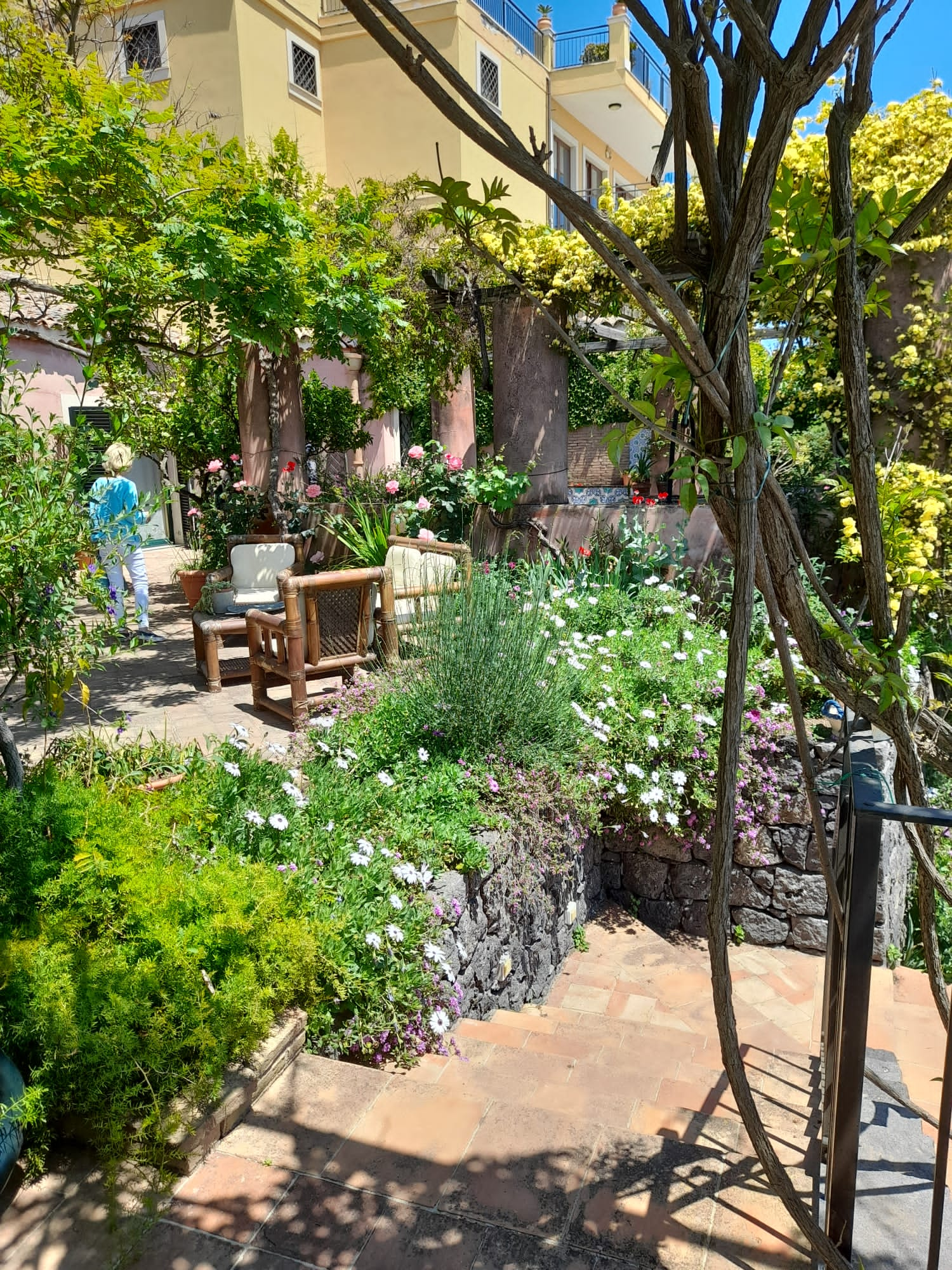
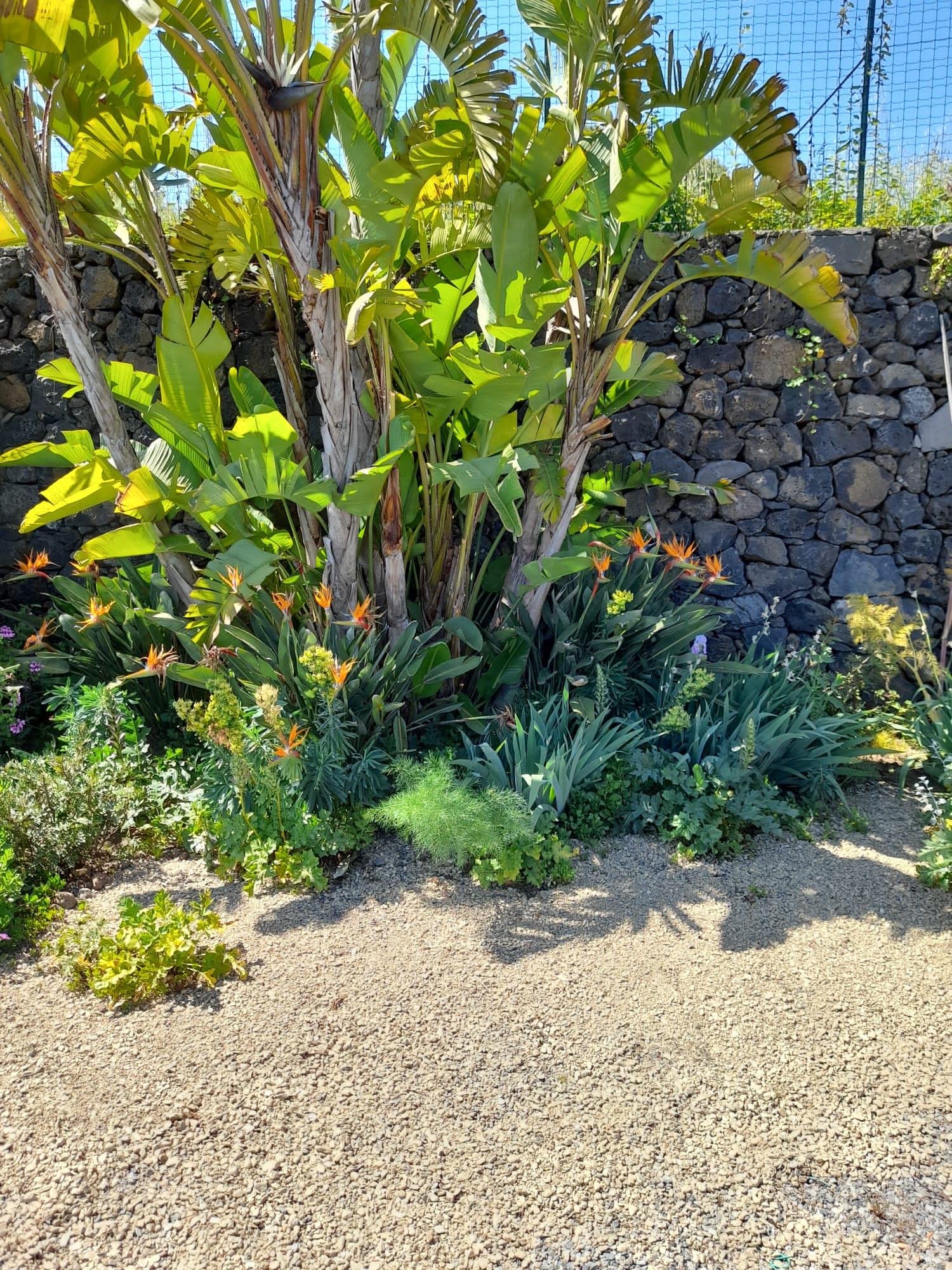
Garden of Guilia Gravina
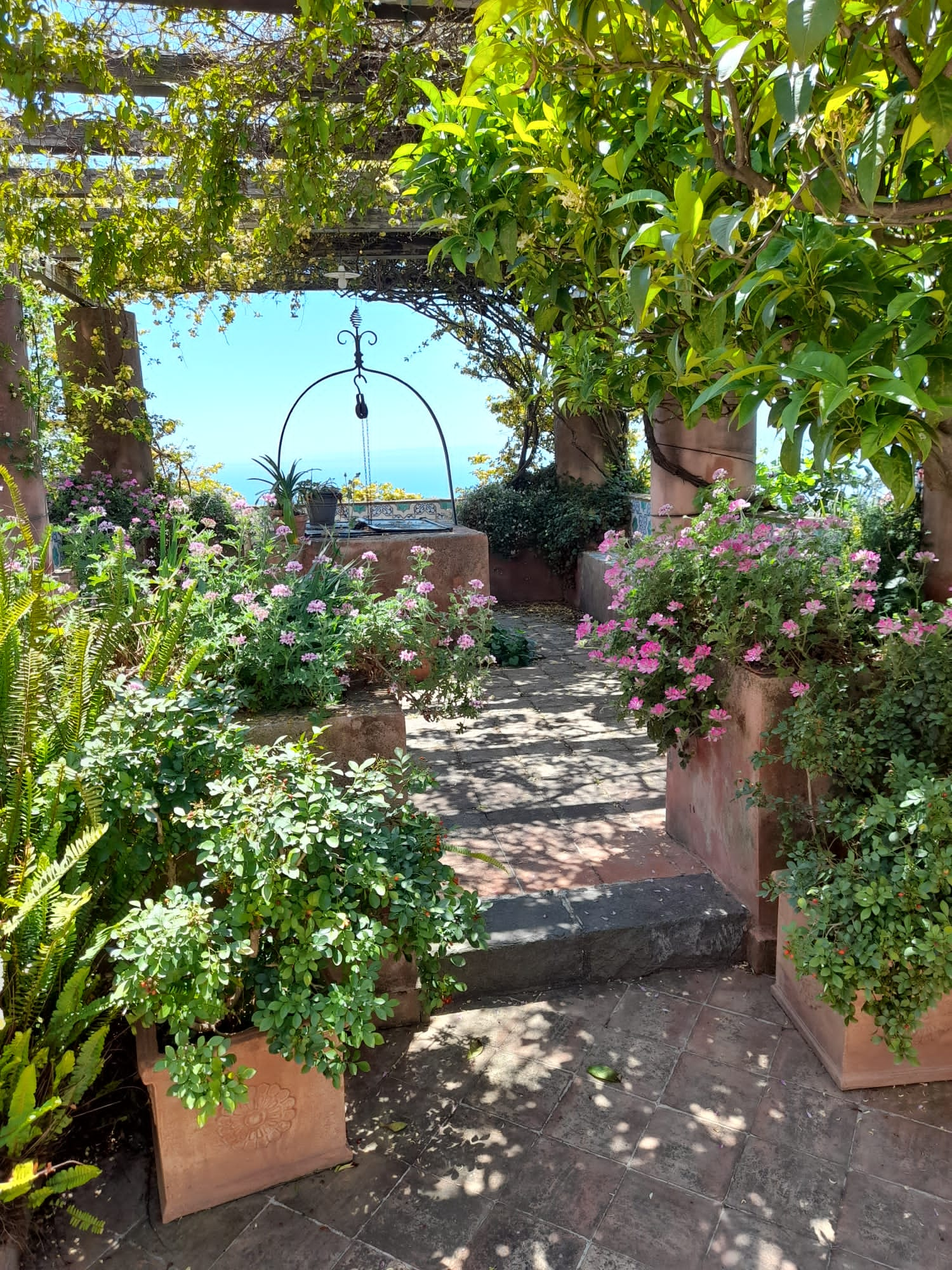
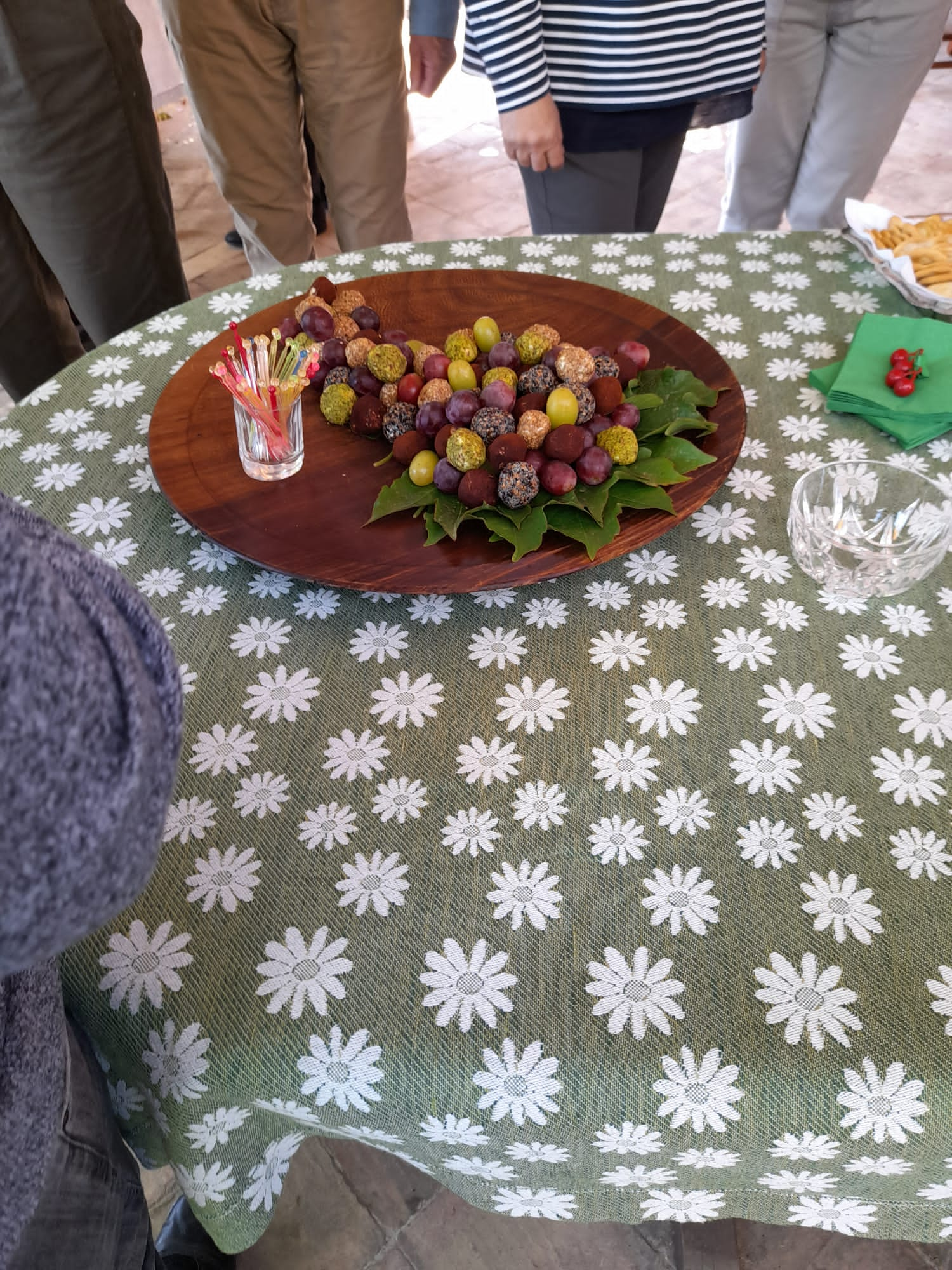
Admiring a dish of cheese balls and grapes
Around the house and terrace, looking out over the sea, is a riot of colour from a glorious creamy yellow Rosa banksiae, clumps of daisy-like Brachyscome iberidifolia, very pretty pink Pelargonium graveolens, Solanum crispum and Bougainvillea.
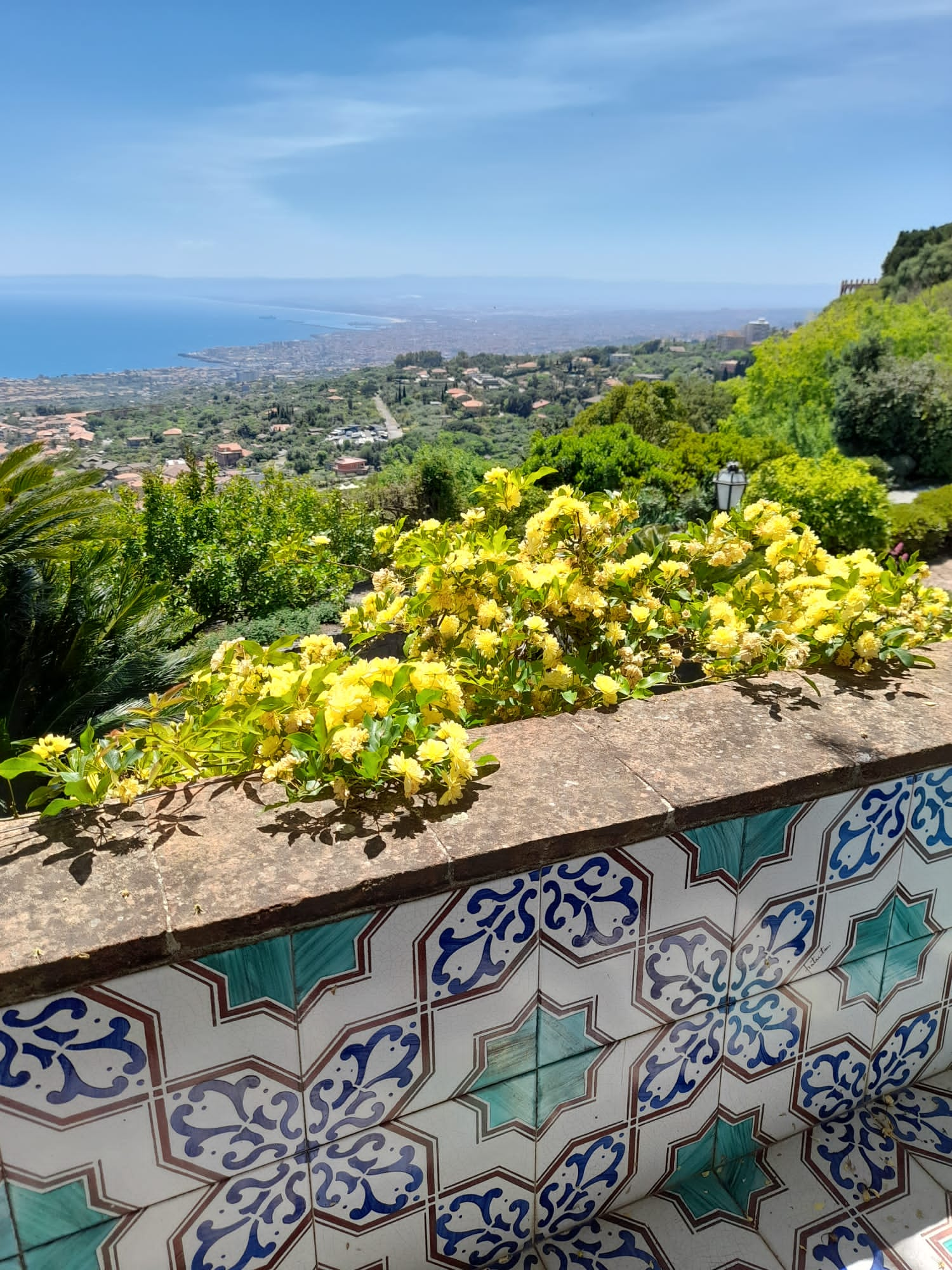
Rosa banksiae
Lower down (on the edge of a long-extinct crater) were olive trees, cypress, the strawberry tree Arbutus unedo, as well as many citrus varieties, including the thick-skinned Citron, and Pittosporum tobira scenting the air.
Water conservation is an important concern to our hostess, and that of other gardens we visited, so everything has to be drought tolerant. It was hard to believe that this garden only benefitted from collected rainwater.
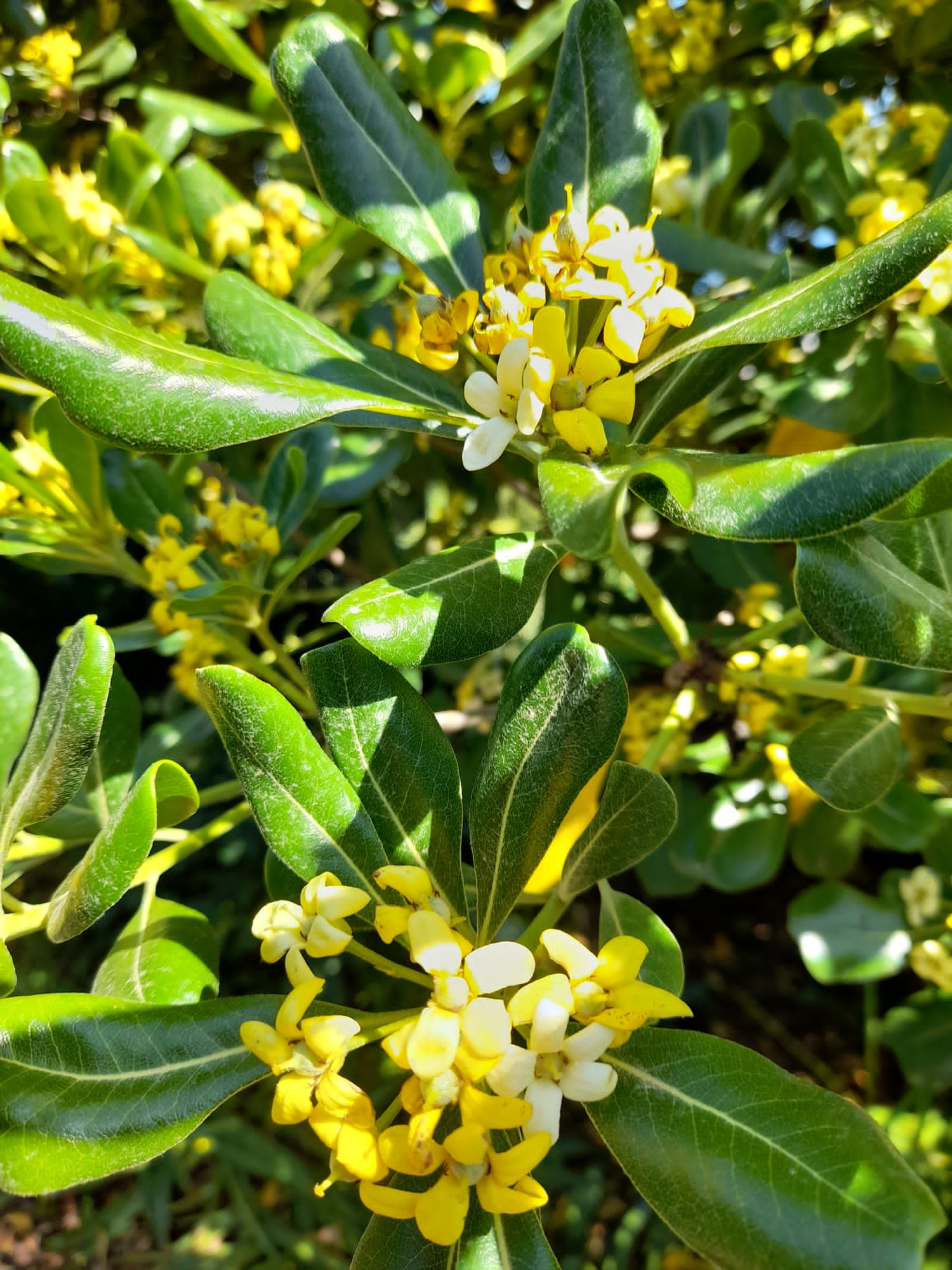
Pittosporum tobira
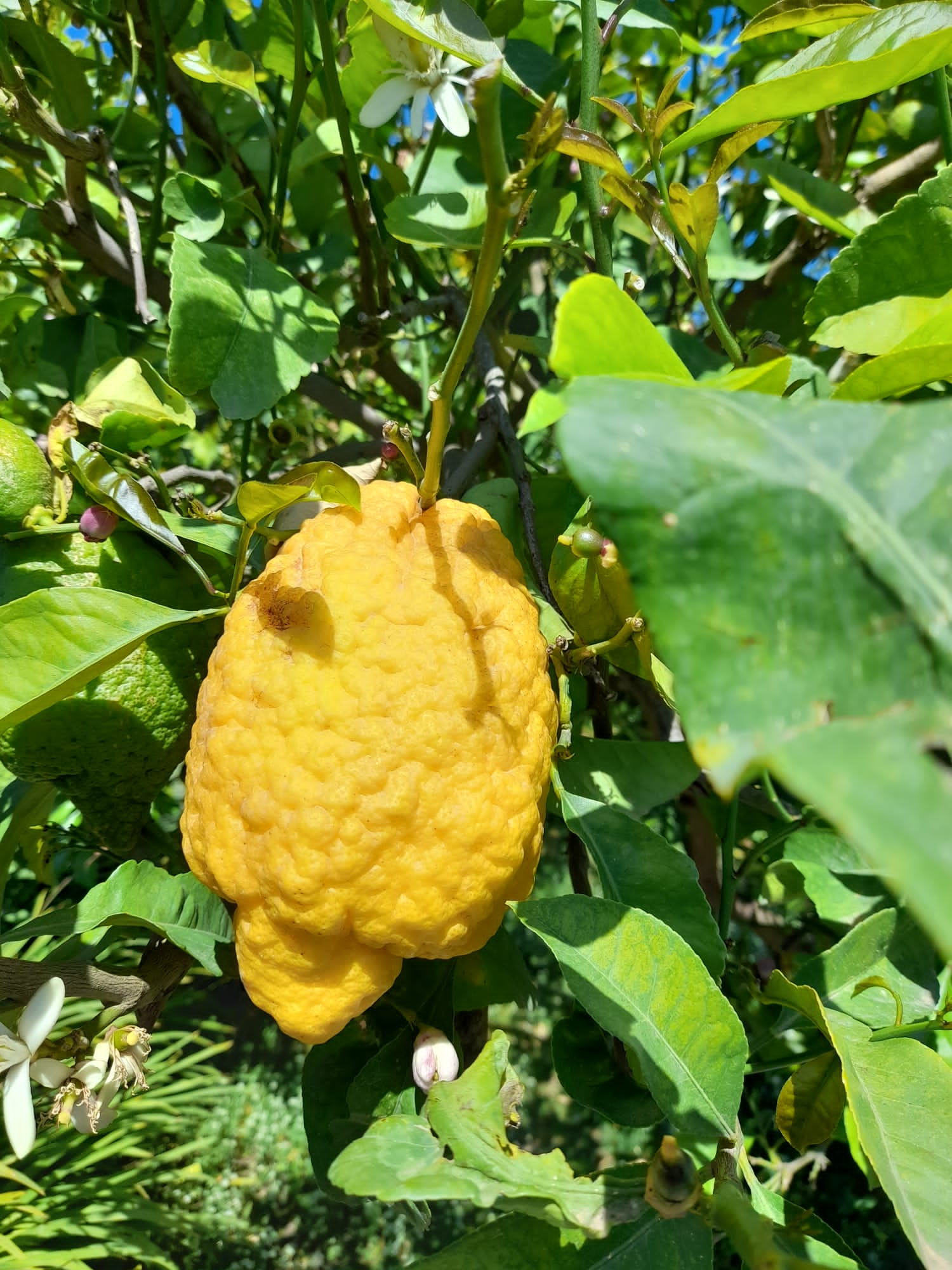
Citron
Our last garden of the day was that of the previously mentioned Ettore Paternò del Toscano at Sant’Agata Li Battiati where we were shown round by his grand-daughter, Stena. This town garden, of about 1.6 hectares, began with citrus – his first passion – before proceeding to exotics with one area dedicated to aloes, agave and a large flowering Cymbidium orchid. Another part of the garden was given over to ‘bush’ plants from higher up the slopes of Etna. Signs of the latter could be seen in a natural cave of lava forming an attractive pond. Amongst the exotics were the Australian quiver tree Aloe ramosissima, candelabra aloe Aloe arborescens and Aloe alooides from South Africa, as well as an immense dragon tree Dracaena draco and various species of palm from the huge Archontophoenix cunninghamiana to the small Sabal minor. As with yesterday’s garden we saw the Callistemon (bottlebrush tree) which was introduced by Stena’s grandfather.
Stena also showed us the restored original Arab watering system of stone channels funnelling from a rain collection tank. At junctions stone ‘gates’ are slotted into grooves to send water one way or another. She also showed us beautiful tiled areas dating from the 18th century and the remains of a great flow of lava, apparently stopped from engulfing the town in 1444 by a veil taken from the statue of St Agatha, hence the chapel dedicated to the saint at the entrance to the garden.
Day 5
Siracusa. We drove to the ancient archaeological park and city of Neapolis, founded in the 5th century BC by Greeks from Corinth. En route we passed the delightful sight of a storks’ nest built like a large pincushion atop a telegraph pole, timeless in its execution whilst modern in its position.

Dionysius’ Ear, Old Siracusa
Entrance to the park, with our guide Lucia, is past the vast limestone quarry from which the city was built and which gives Old Siracusa (Ortigia) its wonderful honeyed hue. Lucia showed us the Greek theatre, still in use annually, overlooking the Great Harbour of Syracuse, and the third largest after Epidaurus and Ephesus despite some 20 odd layers having been removed for building material by later Spanish occupiers. In the surrounding rocks is an impressive aqueduct and also a necropolis in which is said to be the tomb of Archimedes of Syracuse, the great mathematician and inventor, who was killed when the Romans laid siege to the area. Also within these rocks is a large fissure or cavern, now roofless, where Dionysius the Tyrant, around 400 BC, imprisoned his enemies and was able to listen to their plotting due to the natural acoustics. In 1608 this was named Dionysius’ Ear by the painter Caravaggio. Dionysius was also responsible for building a great wall around the harbour at Syracuse to protect it from his battles with the Carthaginians and parts of this can still be seen in Ortigia’s seawall.
Leaving antiquity behind we drove past the result of more modern battles with 1000 headstones in the WWII Commonwealth War Graves cemetery, appearing in sharp contrast to its town cemetery neighbour.
Next stop another large nursery specializing in cacti and succulents: Vivai Cuba at Fontane Bianche was founded in the 1960s by Antonino Palermo. His daughter showed us round an arid but sustainable garden of aloes, agave and yucca, mostly from Africa or South America and mostly grown from seed, with here and there some curious trees such as Kigelia africana from Namibia, called the sausage tree due to its long seed pods, and Quillaja saponaria, the soap bark tree. Also the spiky Ceiba speciosa, seen previously, and the spurge tree Euphorbia dendroides. We stopped beside a pond with a delightful Jeremy Fisher-like frog statue about to leap into a covering of Pontederia crassipes water hyacinth. “Very invasive”, we were warned.
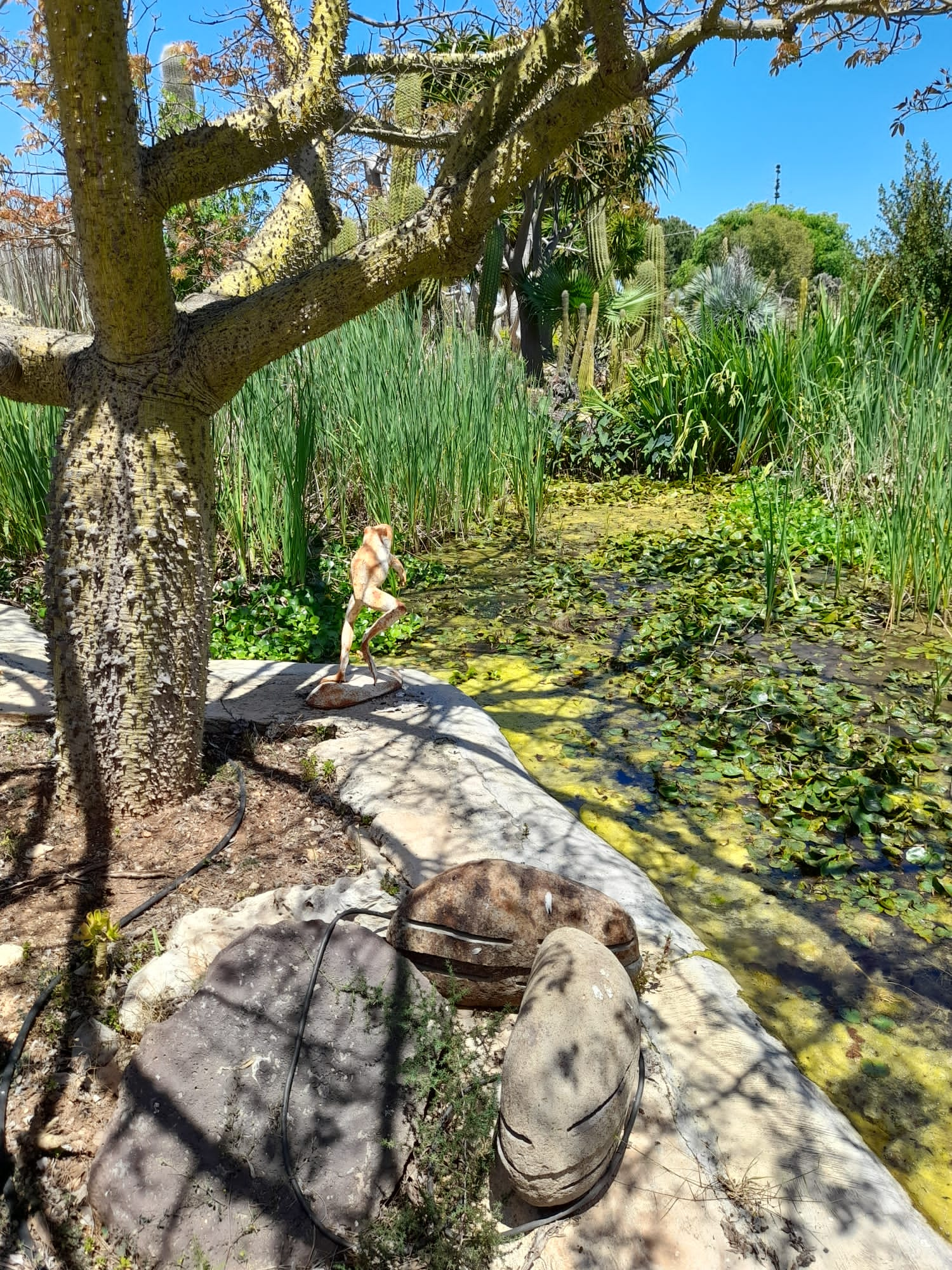
Ceiba speciosa and froggy friend
Our hostess then took us into a large canvas gazebo where we were given a splendid lunch before proceeding to tour the enormous, and hot, greenhouses of cactuses. Here we were shown round by the very tall and laconic Pieter who, with his son, did most of the propagation some from seed and some from cuttings. Grasping between finger and thumb a cactus with 2.5cm spikes he showed us how to cut it in half and leave the end to dry before potting in coir compost and leaving for two years. To prevent laceration Styrofoam can be used to embed the spikes but this method was obviously only for wusses.
Pieter showed us extensive rows of extraordinary cactuses; from a distance some looking like the Manhatten skyline, some like a priest’s biretta or rather intricate patchwork cushion, and some looking like a giant version of some horrible fungus found in the back of my grandmother’s fridge.
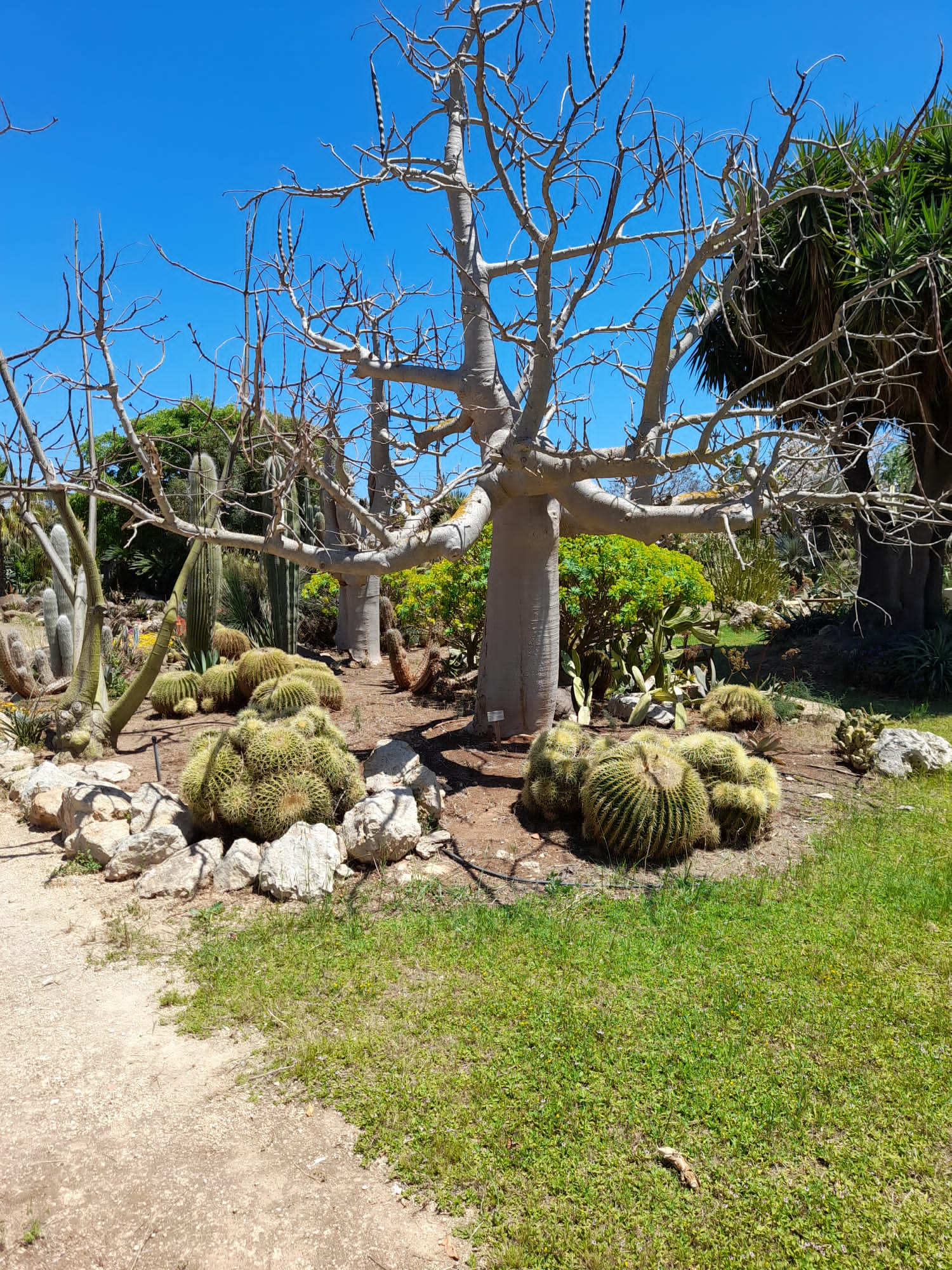

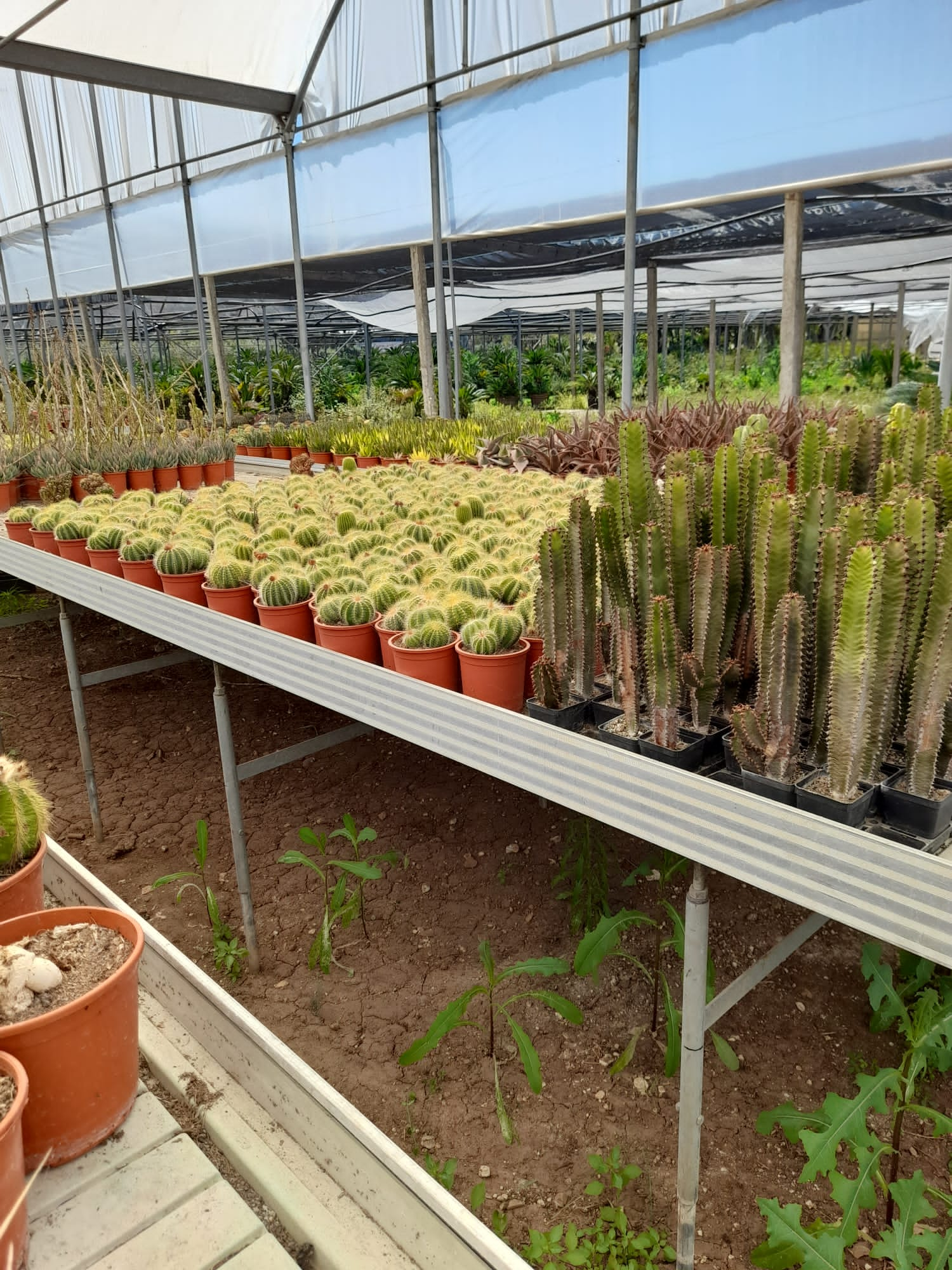
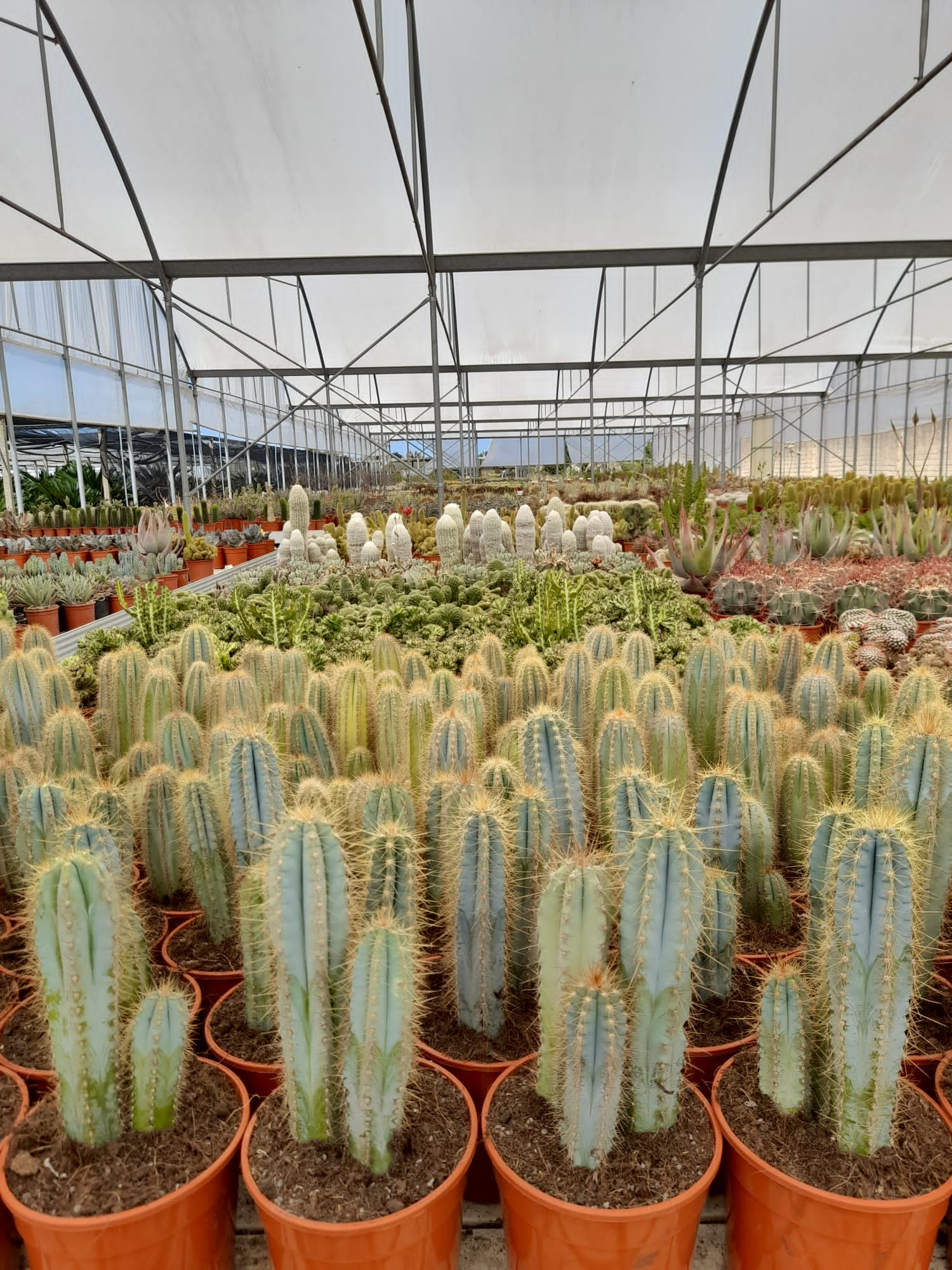
Vivai Cuba Nursery
Ortigia, joined to modern Siracusa by in-and-out bridges, is utterly beautiful and was our base for the next three nights. We stayed in two facing hotels in the old Jewish quarter with narrow streets bisecting each other in a grid system. The limestone glowed in the early evening sunshine and our guide of the morning, Lucia, took us on a quick walking tour before dinner. In the main square we were shown the Cathedral, dedicated to her namesake St Lucia, which was built on the site of the temple of Athena.
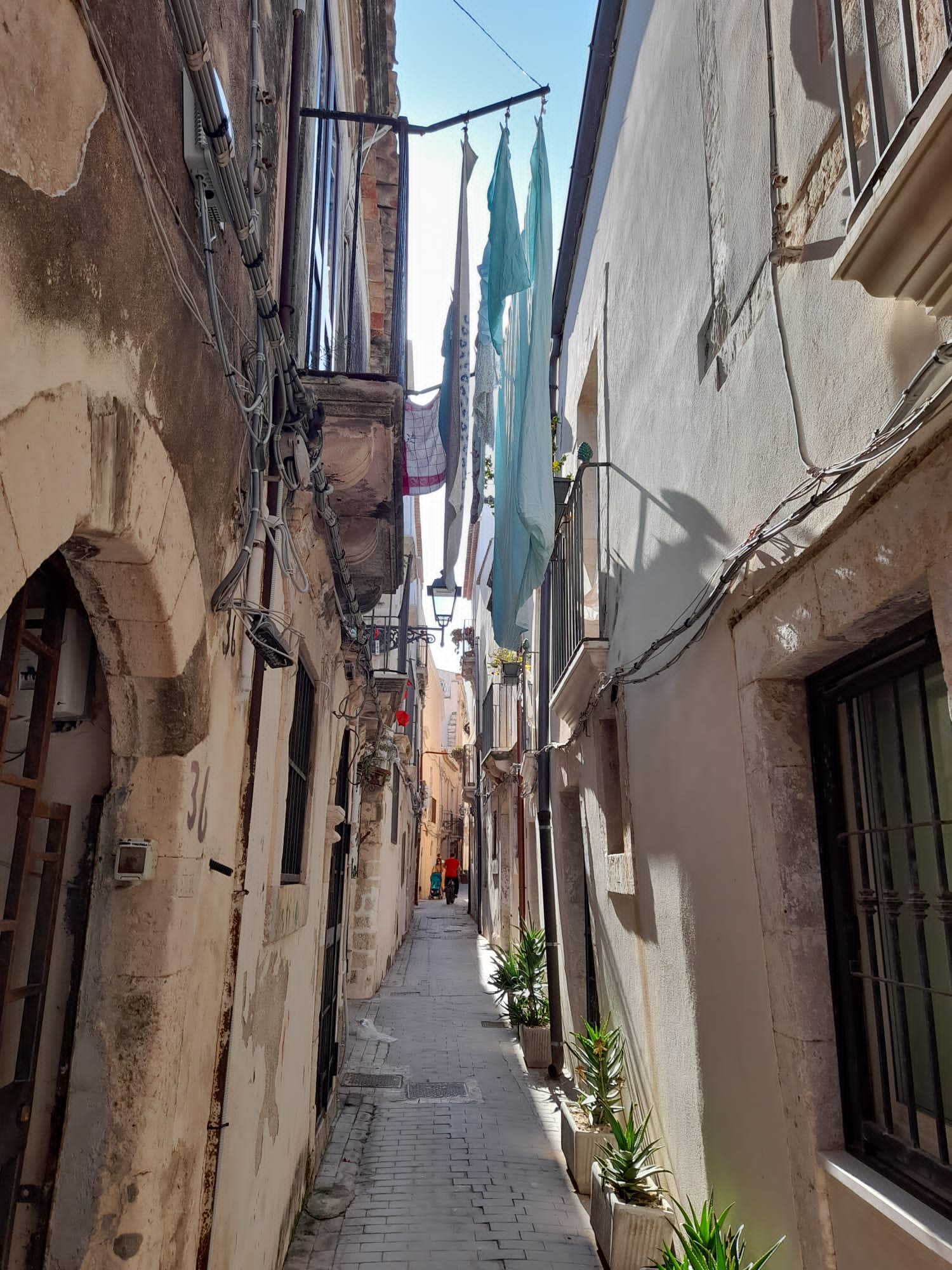
Ortigia’s narrow streets
Inside, where a double christening was in progress, the original 5th century BC Doric columns were still part of the main roof support, and a nod to antiquity was given by the later baroque architect adding Corinthian acanthus-leaf columns to the exterior. Across the square we saw the home of one of Sicily’s aristocrats where Admiral Nelson danced with Lady Hamilton following his victory at Aboukir Bay, and opposite, the Town Hall stood in as the police station in early episodes of Inspector Montalbano. The sublime to the ridiculous.
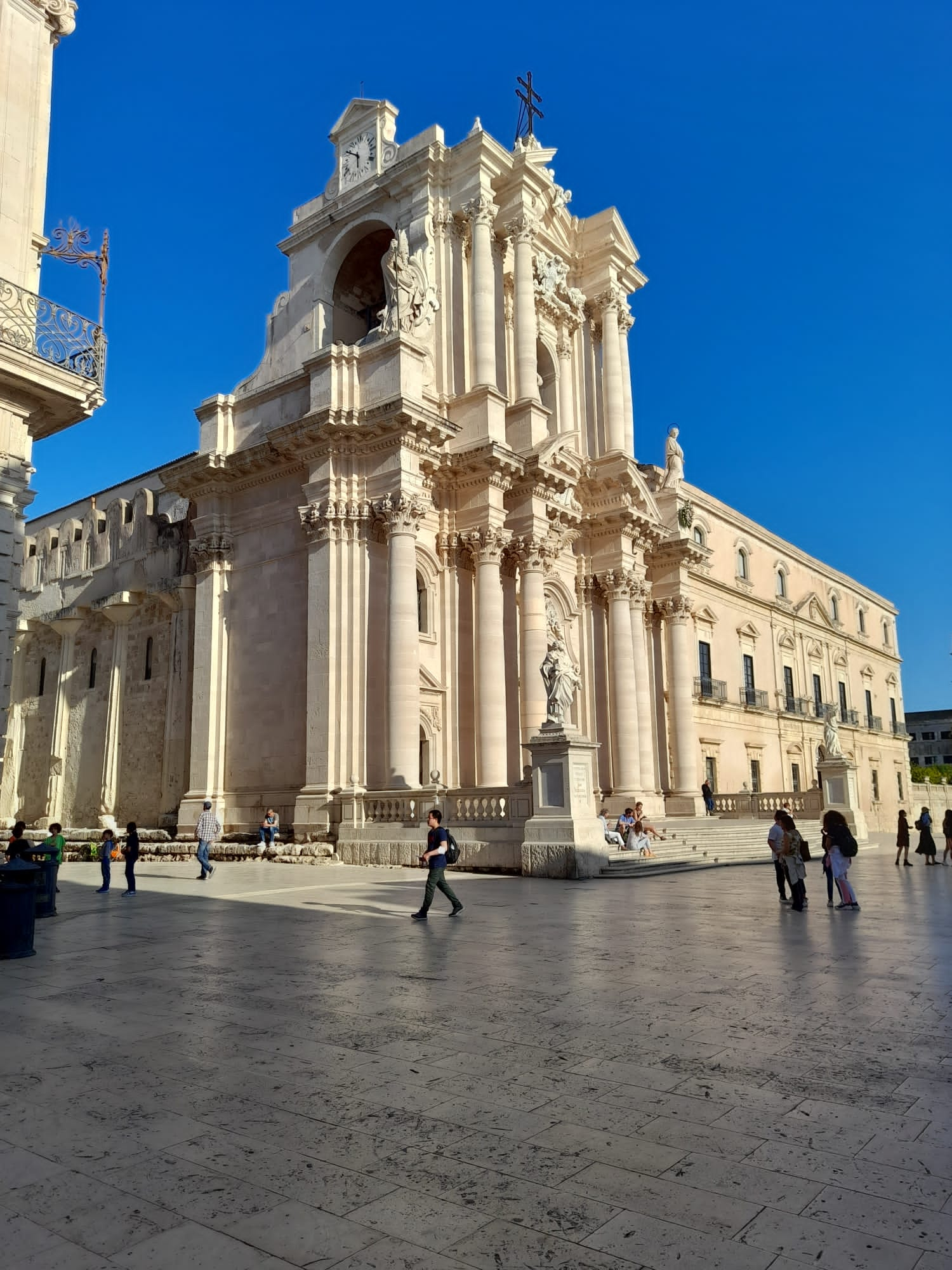
Ortigia’s cathedral incorporating the temple of Athena
Day 6
A late start enabled some of us to indulge in a wander around the market stalls wishing we could take home the wonderful fruit and vegetables on display. At 10.30 we departed for a visit and lunch at the Giardino del Biviere, Villa Borghese at Lentini. This is the Sicilian estate of the nonagenarian Princess Borghese who, following the success of a visit from Queen Elizabeth the Queen Mother in 1988, decided to open the gardens to small guided groups. Our group was fortunate to be shown round by the Princess’ daughter-in-law who gave us a potted history of the area whilst we sat in the family’s private chapel dedicated to St Andrew, the patron saint of fishermen. The relevance of this dedication was due to the original Biviere being a huge and much fished lake, drained and abandoned as part of Mussolini’s attempt to wipe out malaria in the 1930s. Since then the lake has been restored, although much smaller, but the trade of fishing has not returned, leaving many empty houses and an air of abandonment as we drove past.
Prince Scipione and Maria Carla (Miki) Borghese came to the estate (a wedding gift) in 1968, substantially adding to the original 17th century fisherman’s house and slowly creating the garden. Near the entrance is an enormous Ficus with vast roots creeping above the ground, and around the terracotta-paved terrace are lemon trees, grafted onto grapefruit, and a huge 25-year-old cactus standing sentinel against the wall. We were shown Parkinsonia aculeata, much admired by the Queen Mum, a very pretty Tabebuia impetiginosa (pink trumpet tree), as well as the false pepper tree and Moroccan birch. An area of lawn, hedged with Berberis thunbergii, had clumps of Strelitzia reginae and a fisherman’s old metal coracle was dramatically planted with a large Agave americana, this area having been part of the original lake whose piers were made into beds for aloes, sedum, euphorbia and yucca. Lower down, beside the swimming pool, were palms planted in 1984, Cupressus sempervirens and several monumental pines.
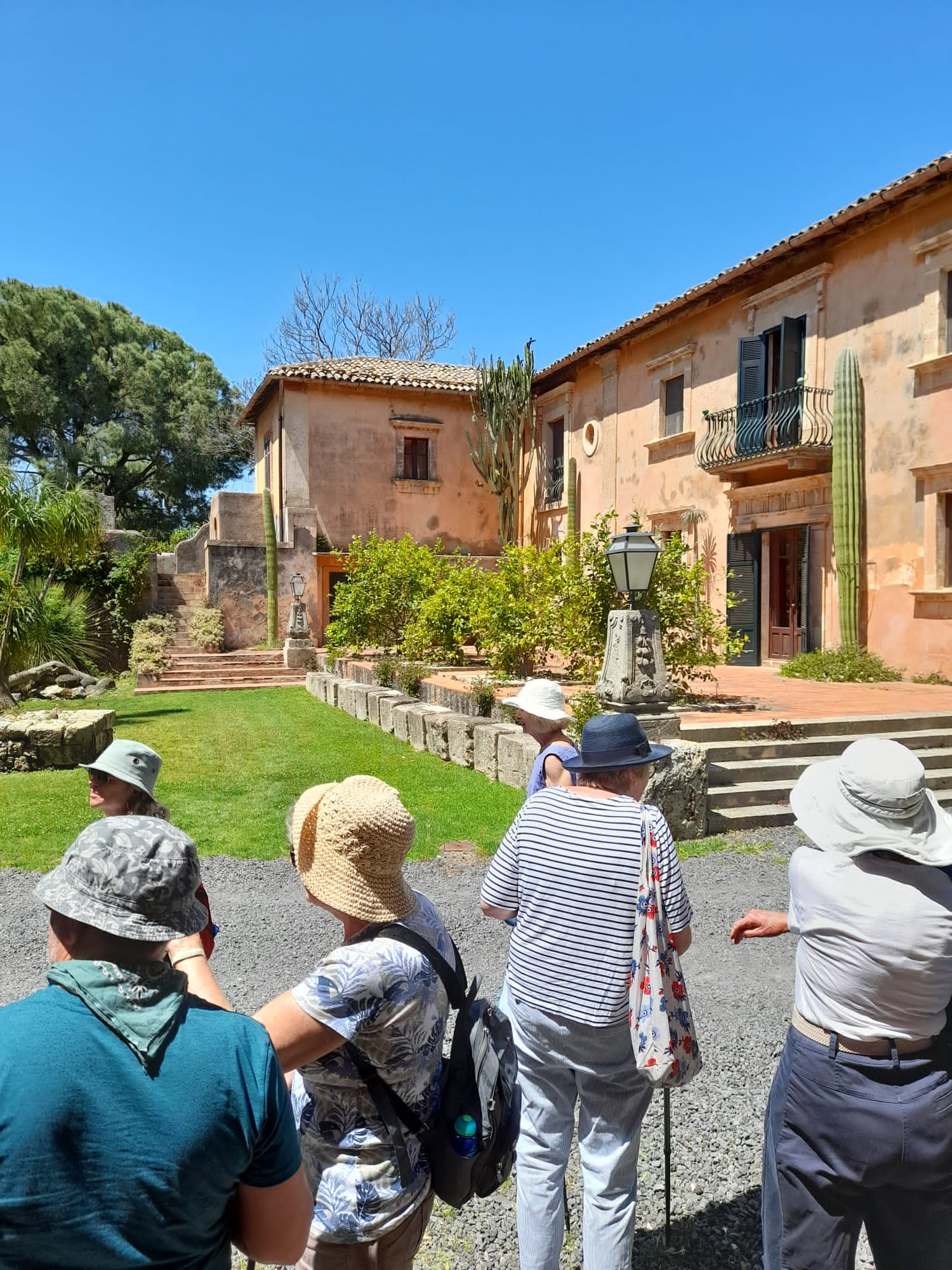
Villa Borghese, Giardino del Biviere
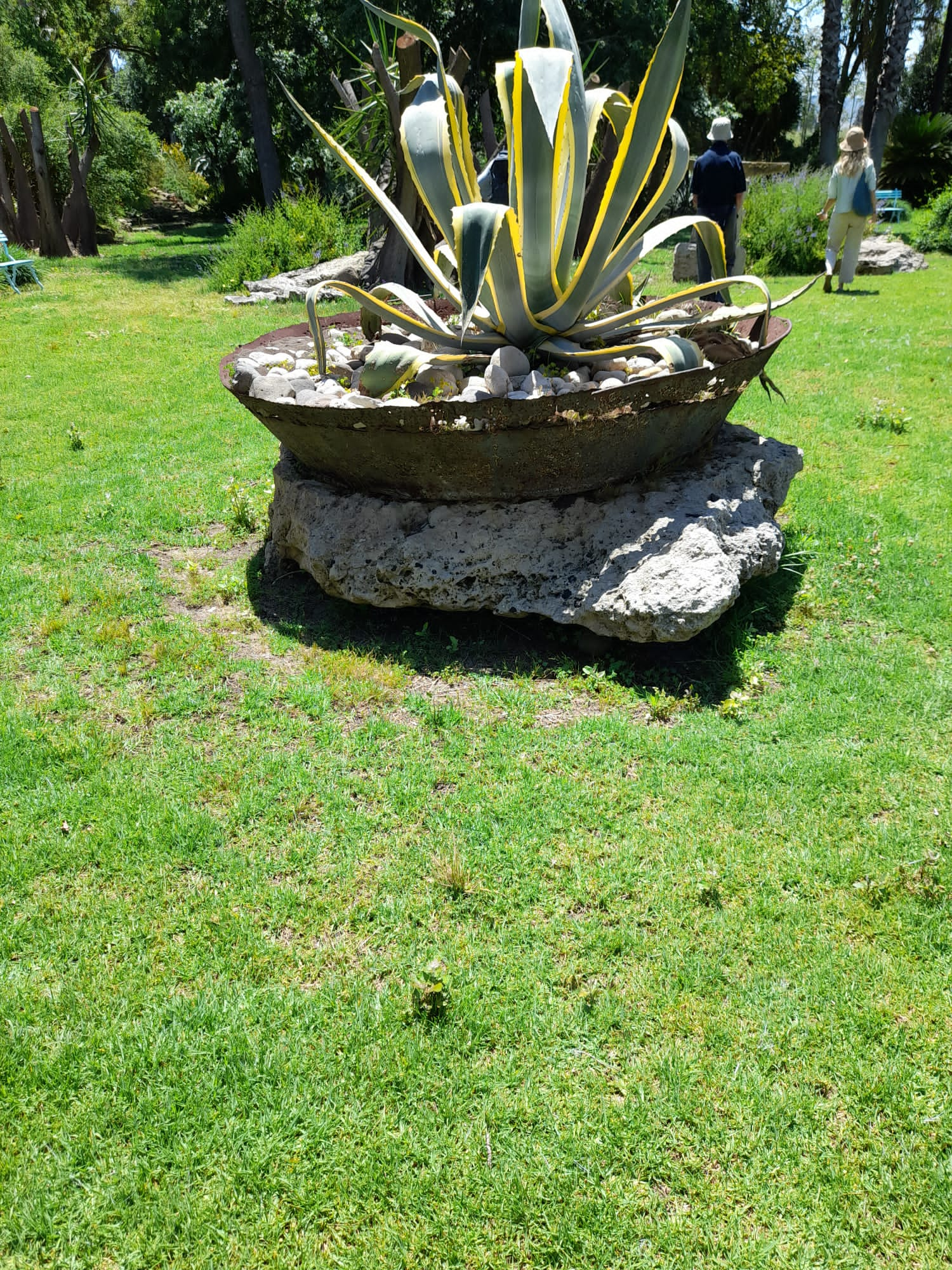
Agave americana
We were given another wonderful lunch followed by an opportunity to buy some delicious honey flavoured by the flowers in their organic citrus orchard before departing for our visit to Giardino San Giuliano at Villasmundo.
This garden of 3 hectares is part of a 60-hectare, mostly citrus, estate belonging to the family of the Marquis of San Giuliano for over 800 years. At the end of the 70s the late Marquis Giuseppe di San Giuliano and his wife Fiamma Ferragamo began making a tropical-inspired garden as a reminder of time he spent in Brazil. The house was originally a fortified farmhouse and is surrounded by a lush lawn with palm trees – Brahea, Archontophoenix and Washingtonia – a huge South American Phytolacca dioica and a banyan-type Ficus with aerial roots looking like props holding up the branches.
In the shadier parts of the garden we walked along beautiful stone and pebble mosaic paths made to emulate Persian carpet-runners. There was the same falaj water system as seen elsewhere. Here we found citrus – particularly blood oranges which thrive in this climate – and pomelos (Citrus maxima) with large headily-scented blossoms. In the inner courtyard of the pink painted farmhouse was an enormous Ficus magnoliodes and the walls were covered in bougainvillea and pretty caper flowers.
Leaving via a more arid-looking area we passed a collection of yuccas and cactuses, Agave ferox and the ubiquitous Opuntia indica framing an ornate baroque fountain.
Day 7
No garden today but a walking tour of the nature reserve at Pantalica. We travelled through a delightfully rural landscape with drifts of scarlet poppies in all the field margins and pink valerian and acanthus along the roadside. In the distance we saw hilltop villages with terracing and groves of pomegranate, and lemon trees. The reserve was surrounded by an impressively long drystone wall and here we were introduced to the local ranger who guided our walk, stopping from time to time to point out various wild plants and trees, such as Ferula, Allium neapolitanum, Artemisia, Phlomis fruticosa (Jerusalem sage), Psoralea bituminosa, Querus ilex, wild pear and Ceratonia siliqua (carob tree). The latter, so we learnt, not only provides a cocoa substitute but also a thickening agent from the seed pod pulp. In addition each seed weighs a fifth of a gram which equals one carat. Who knew?
During our walk, glimpsing the Anapo river below (containing trout unique to the area) which feeds the Neapolis Syracuse aqueduct, we were shown Bronze Age tombs dating from the 13th to the 8th century BC and sealed with a stick secured between two holes. Inside some were found bronze safety pins, and hematite artefacts dating from the early iron age. Further on were enlarged tombs used by the Byzantians as safe havens from Arab attack, and at the summit of the hill was the ruined eight-roomed palace of the Prince of Pantalia dating from the 13th century BC.
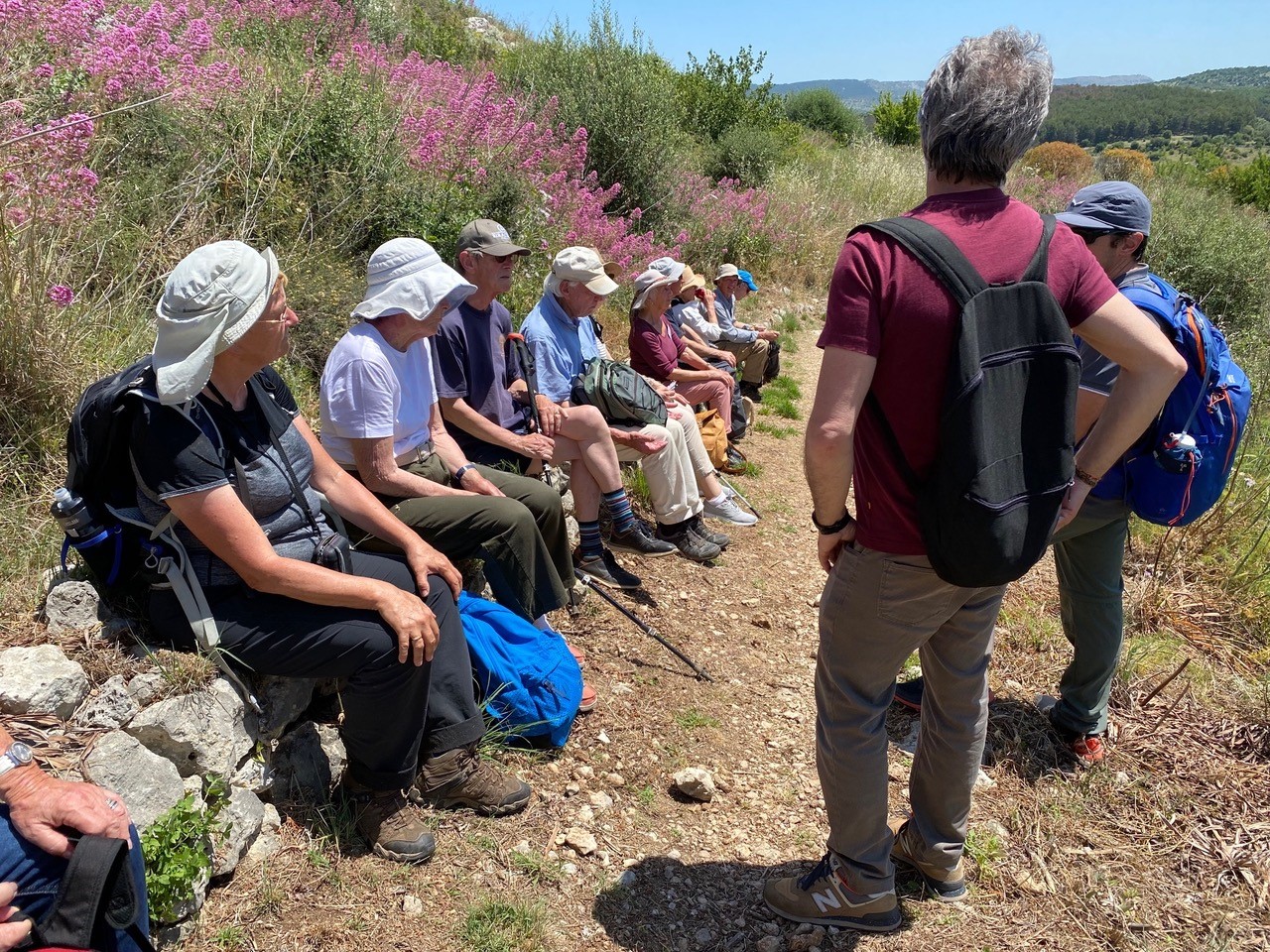
Our group on the nature walk
Following our walk, up hill and down dale in hot sunshine, lunch was at Agriturismo Borgo degli Ulivi at Palazzolo Acreide. This was another feast of local dishes, including barbecued Sicilian sausage. Interestingly, at all our lunchtime visits we were treated to more varied and authentic foods than in many of our hotel or restaurant dinners. Lemony rice and spinach and tomato frittata were memorable as was a stuffed flat bread called sciachiatta. For pudding at the Villa Borghese we had fresh ricotta with their citrus blossom honey, the former being unlike any I had tasted before. The same might be said of a fresh mozzarella with tomatoes that we were given at Donna Carmela. My favourite dinner dishes were stuffed sardines, crispy anchovy fillets and caponata (aubergine, fennel and peppers) with swordfish.
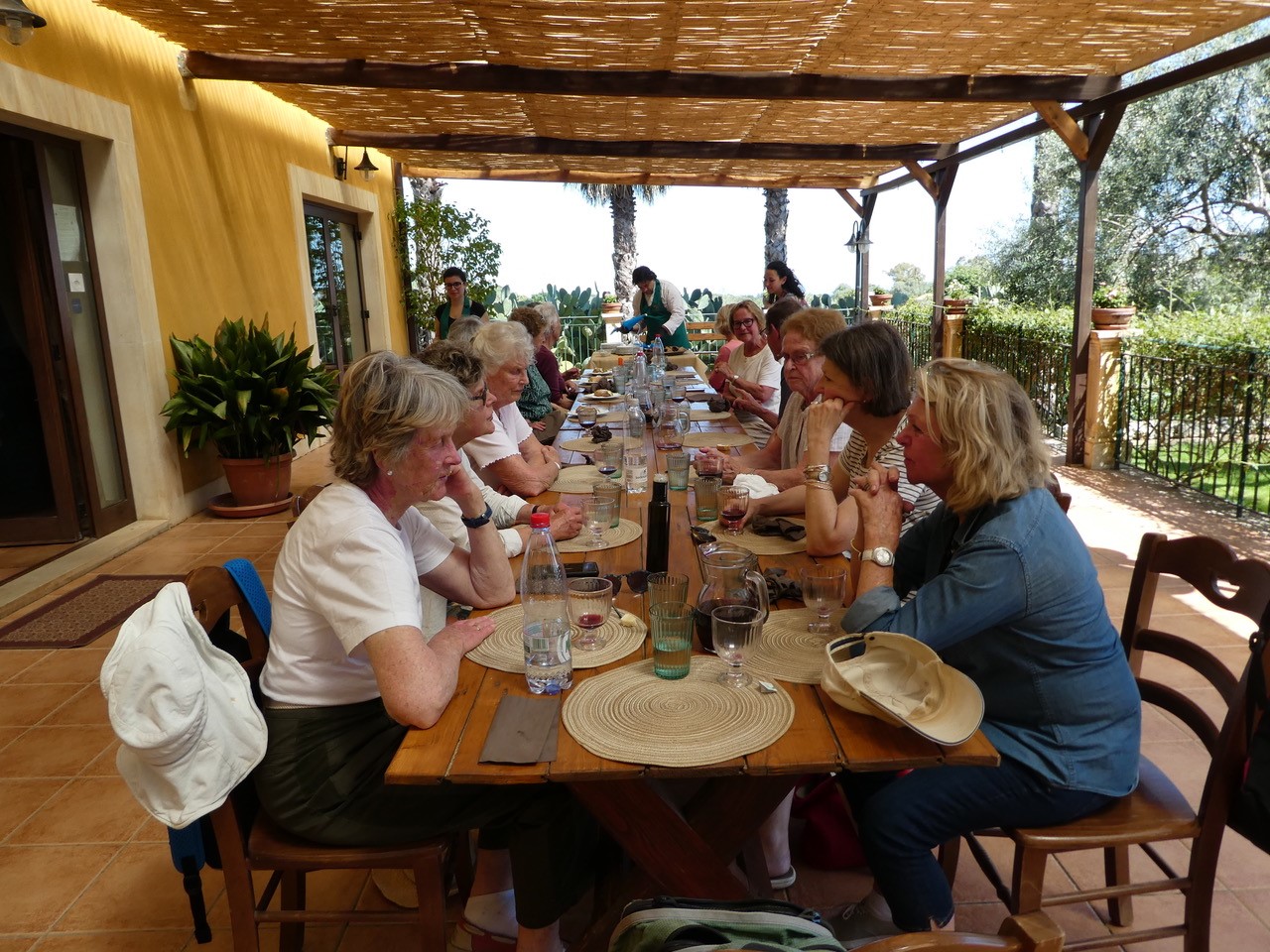
Lunch at Agriturismo Borgo degli Ulivi
I should mention that wherever we went we heard about the travails of keeping palms alive. The wretched Rhynchophorus ferrugineus weevil, which Italians call the punteruolo rosso, has caused the destruction of many date palms but some – Washingtonia filifera and Washingtonia robusta – seem immune. At Villa Pennisi gardeners shin up the trunks to inject systematic insecticides directly into the canopy. Both nurseries said that the bottom had fallen out of the palm market, bio security being as much of a headache as climate change.
Finally, huge thanks to Maddy Hughes, and to Geoff, for wonderful organisation and patience, and for negotiating lighter dinners. And thanks to the numerous members of our group, all more knowledgeable than me, for their much needed help with plant identification.
Text: Briony Marriott
Images: Briony Marriott and Maddy Hughes

Date palms

